Disclaimer: This post contains affiliate links to handpicked partners, including tours, gear and booking sites. If you click through or buy something via one of them, I may receive a small commission. This is at no extra cost to you and allows this site to keep running.
This Cuba travel guide is frequently updated, especially in light of political changes and tourism regulations, to ensure it remains one of the most comprehensive and up-to-date overviews on visiting this Caribbean island.
Cuba is every sound and shade of Caribbean beautiful on the surface – famed for its world-class cigars, infectious street music, vintage Cadillacs and decaying pastel painted mansions. Beneath that, Cuba is an island unlike its neighbours – fractured by Communist rule and archaic social systems that make travelling here frustrating.
A source of fascination and media frenzy that was once only accessible to outsiders via its paradise beach hubs and neighbouring cities, travelling to Cuba has been open across the entire island for quite some time.
It’s one of the most captivating places you will ever visit and deemed the most fascinating of all the Caribbean. However, away from cruise ship excursions and resort holidays, Cuba is not an easy place to travel. Yet it is worth the challenge if you are curious enough to dig deeper.
Here’s how to prepare for all the things you will encounter on the ground with insider travel tips and helpful information sourced after spending one month travelling all around the country.
Travel extensively, and you’ll soon see that change is more crucial than those selfishly crying out, following the recent death of Fidel Castro, to pack in those Cuba trips before it does.
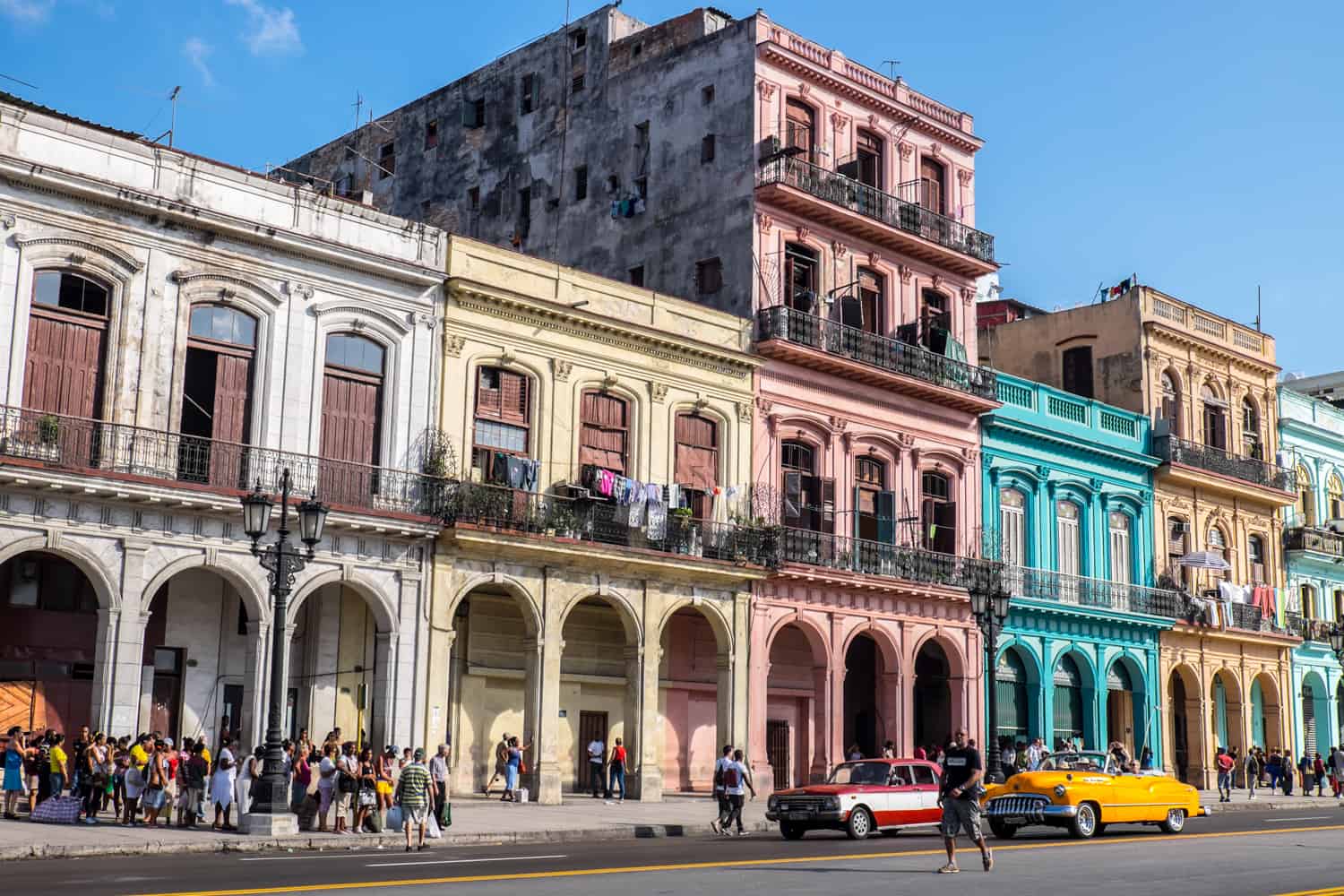
How to Travel to Cuba Guide: Understanding the Frustrations and Fascinations
Contents
- Ditch Your Preconceptions of Cuba
- Best Time to Go
- Getting Into Cuba
- Can Americans Travel to Cuba? Here’s How.
- Flying to Cuba
- Preparation for Independent Travel
- Currency and Money in Cuba
- How Much Does it Cost to Travel in Cuba?
- Where to Stay in Cuba
- Is Cuba Safe to Visit?
- Food in Cuba – Lower Your Expectations
- Cuba Transport System
- Access to the Internet
- Do I Need to Learn Spanish?
- Bring Medication & Essentials – Cuba’s Limited Supplies
- Daily Life in Cuba – The Ration Nation
- The Frustrations of Cuba Travel
- Suggested Books About Cuba for Inspiration
Ditch Your Preconceptions of Cuba
There are many reasons to visit Cuba, but one should be to break down your preconceptions and shatter some illusions you may have of the place because you will come face-to-face with many contradictions when there.
Cuba is a country whose slow climb to normality is what many foreign visitors inadvertently come to see.
Its people are welcoming and will greet you with a smile, yet most live in struggle.
The retro cars and crumbling buildings may be kitsch and a step back in time, but they are a reminder of the country’s thwarted growth.
Rules for travelling here are changing, and visitor numbers are rising. Cuba tourism rests on the appeal of this window to the past.
However, there’s a much bigger picture that you do not see until you are there.
Beyond the typical travel route of Havana, Viñales, and Varadero, I spent a month travelling further afield with two friends, venturing to Matanzas, Santa Clara, Remedios, Cienfuegos, Trinidad, Camagüey, Santiago De Cuba, Sancti Spiritus, and Baracoa.
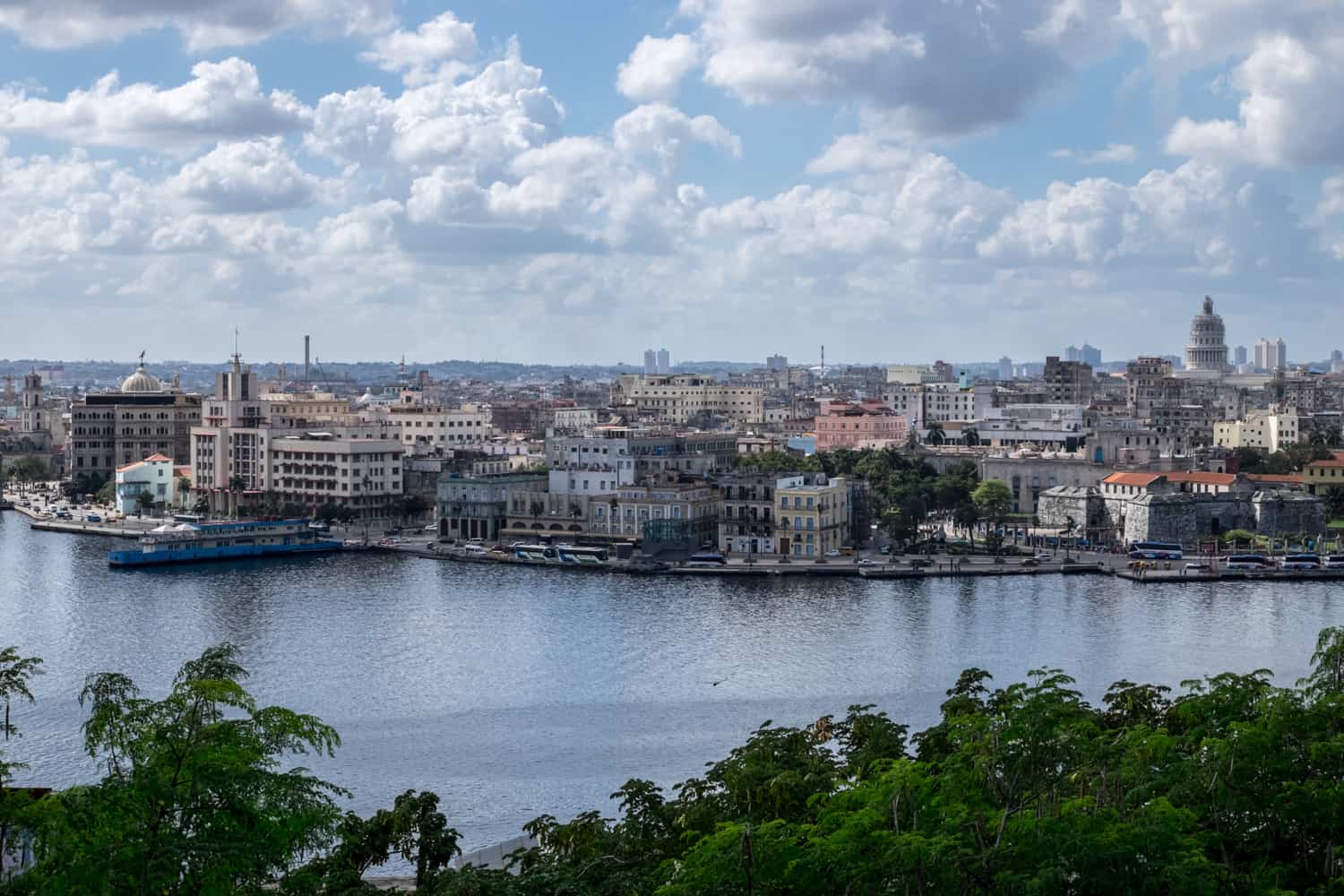
City of Havava, Cuba.
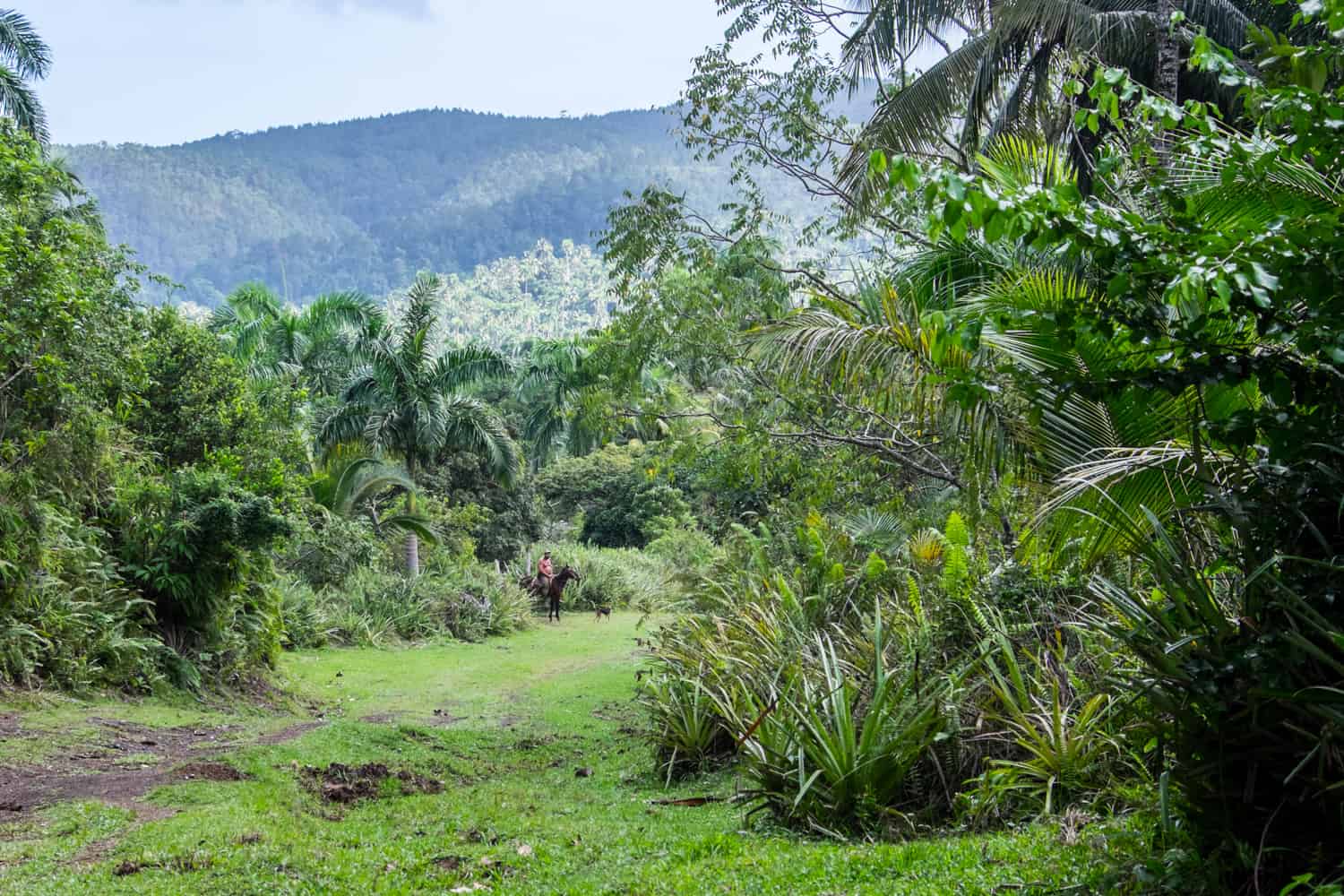
In Viñales – the countryside of Cuba.
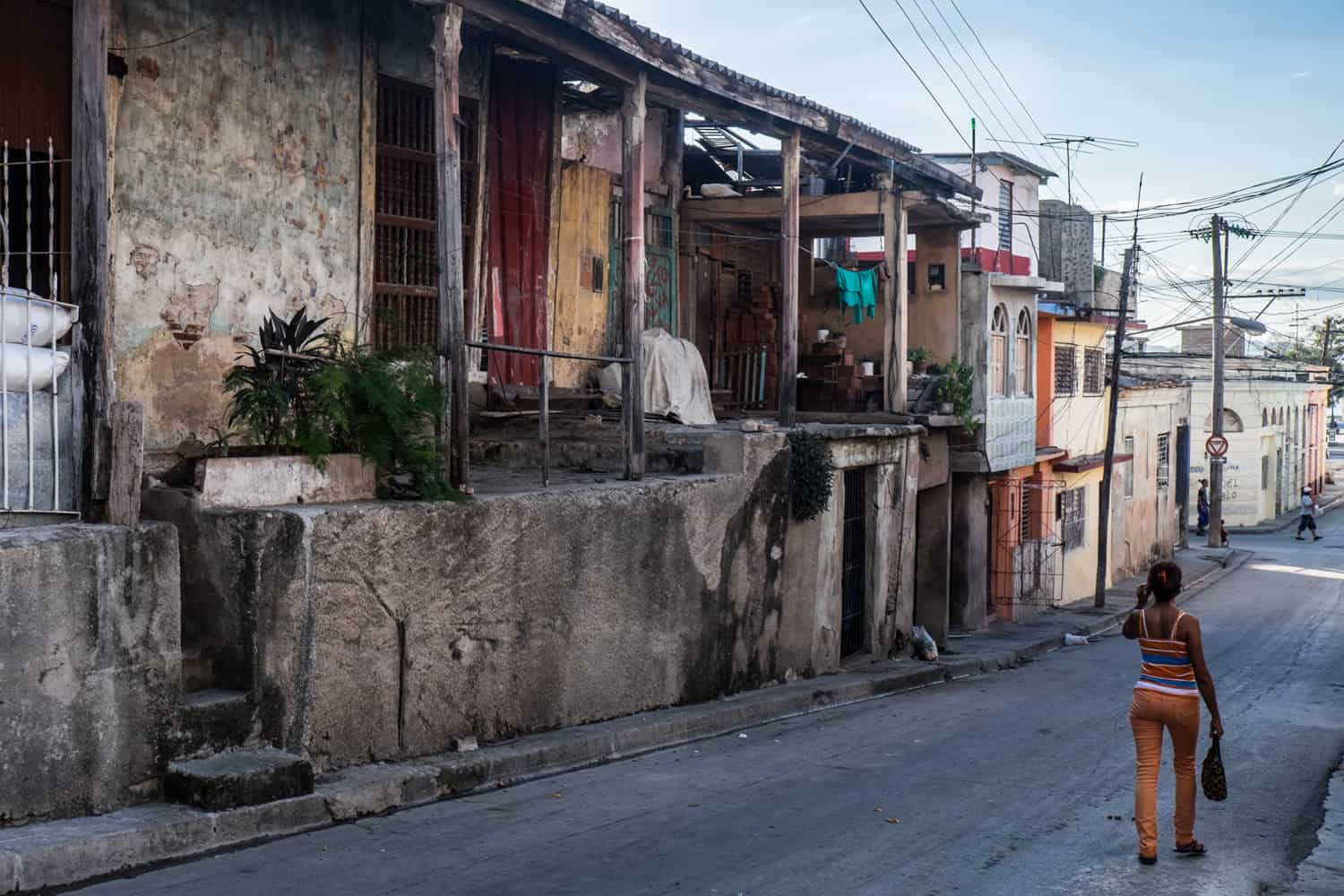
Neighbourhood in Santiago de Cuba.
We were determined to uncover the country and its multi-layered landscapes and regions, knowing it wouldn’t always be easy.
It’s hard to put into words what we saw and heard. As a tourist, it was hard work to find out the information needed to get a clearer picture.
There were things we loved, loathed, and found confusing. There were many things to do in Cuba, which turned into heartbreaking things to see.
There were first-hand lessons of Cuba’s history in every town and city and quiet street corner. Those lessons summoned daily debates over dinner about what aspects of this communist society work in the present day and those that don’t.
Going to Cuba shatters a lot of dreams.
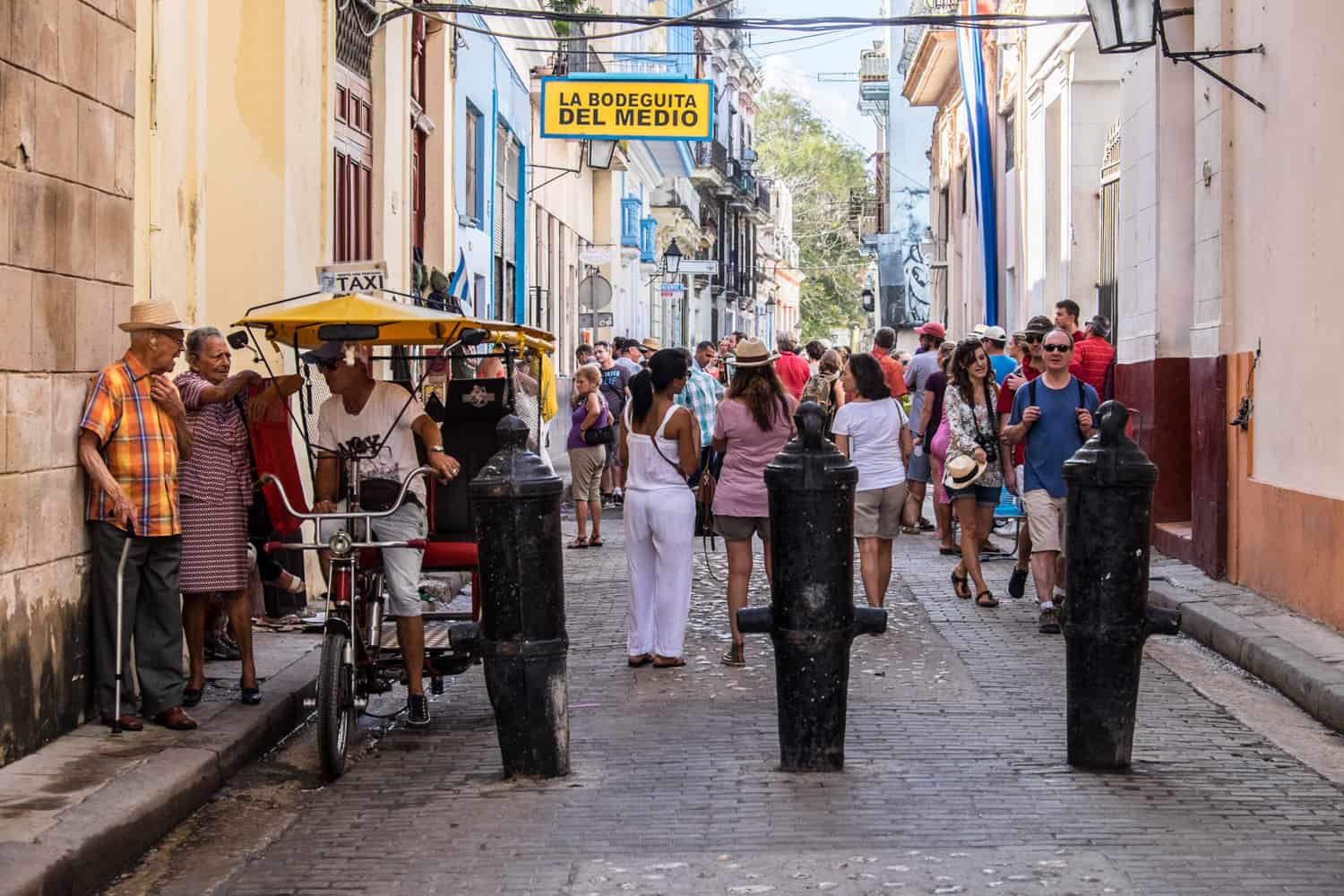
La Bodeguita Del Medio – a popular hotspot in Havana city.
Best Time to Go
The dry season, typically from November to April, is the best time to visit Cuba.
May to October is the wet season, with heavy rains and hurricanes. Monitor the weather forecast and track the progress of approaching storms.
I visited in December, at the start of the dry season. While we had many sun-drenched days, we also had sporadic rain, which didn’t last too long. Since Cuba has a subtropical climate, this is to be expected.
Getting Into Cuba
How to Get a Tourist Visa for Cuba
Check With the Airline if a Visa is Included
You don’t need a visa to go to Cuba now; in most cases, a visa is included in your flight ticket price. Check with your travel agent or airline before you leave.
I travelled with WestJet from Toronto, and despite it not being a part of a package holiday, I was given a visa slip free of charge. That was after getting a visa at the embassy in London as a precaution, at the cost of £15.
Visa and Passport Requirements
The visa, known as the Tourist Card, gives you valid entry to Cuba for 30 days with a single entry. Your passport needs to be valid for two months after your departure date, although I always think it’s wise to be cautious and have at least six months’ validity on your passport to avoid any issues.
You should also have proof of your return flight from Cuba, alongside the booking of your first accommodation at your destination of arrival. We flew into Varadero and had an e-mail confirming our casa booking, just in case we needed to show it. It was this address that we added to the visa form.
Travel Insurance is Mandatory
The Cuban government announced in early 2010 that all foreign visitors going into Cuba must have a travel insurance policy covering the entire duration of their trip before they enter the country. I was never once asked to produce my documents upon arrival, although I had a printed copy just in case. Regardless, you shouldn’t travel without travel insurance. Some policies do not cover Cuba, so check the fine print. Medical assistance, in particular, can be costly here.
Airport Departure Tax
When leaving Cuba, remember to keep 25 CUC ($25) for the Airport Departure Tax, which you will pay to the officials at passport control as they stamp you out of the country.
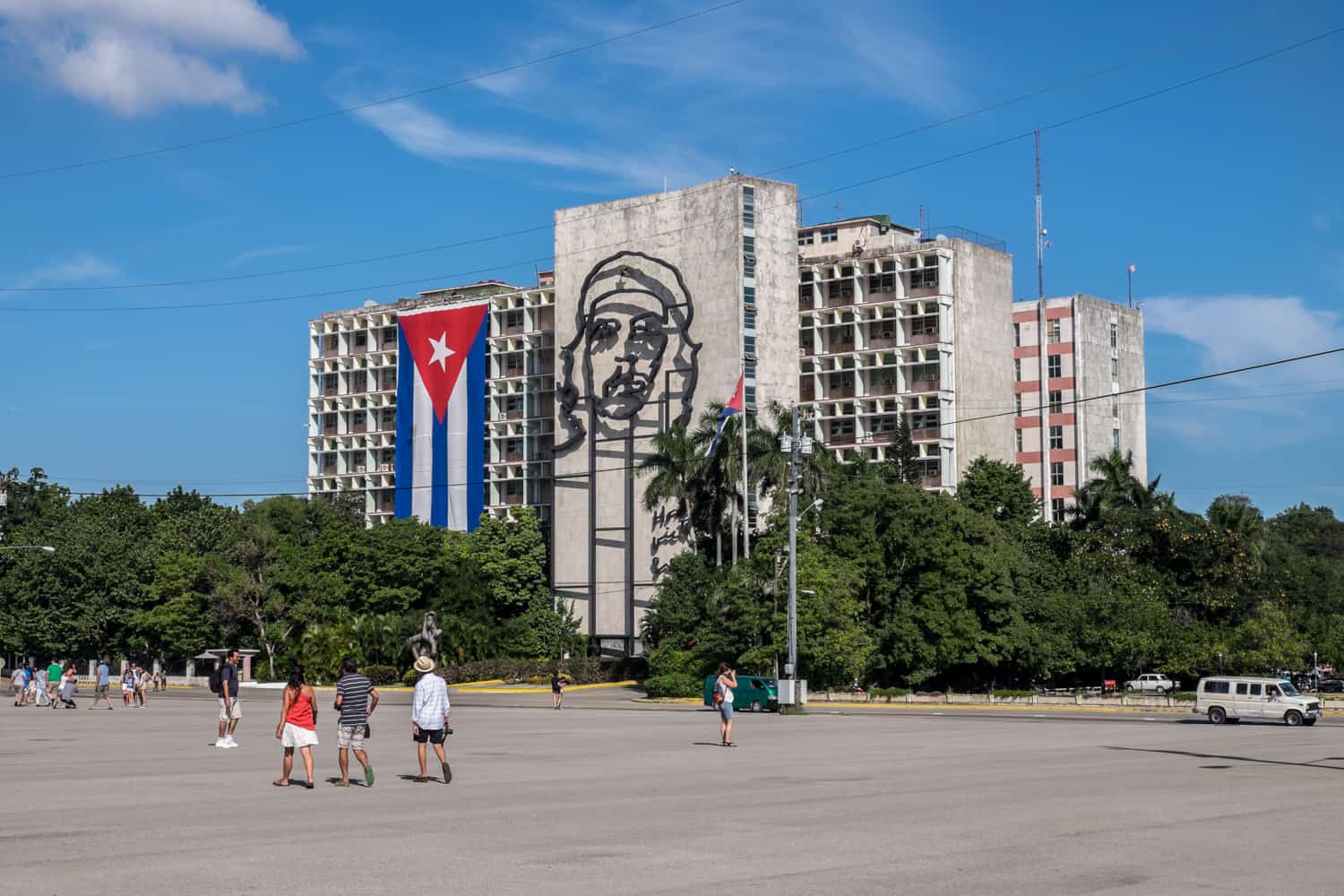
Plaza de la Revolución (Revolution Square) in Havana.
Can Americans Travel to Cuba? Here’s How.
Yes, Americans can go to Cuba despite the confusing information presented. Traveling here from the US has always been effectively illegal without going through the proper license channels, but there were ways around it without any serious repercussions.
Americans considering Cuba as a travel destination have options now, but many have entered for years in organised tour groups or with a special license following written permission.
Americans traveling to Cuba via Canada or Mexico
Most American travellers in Cuba who were travelling independently told us they got around such restrictions by flying via a non-US Gateway like Canada or Mexico. On return, their Cuba visa card was stamped instead of their passport to avoid issues with US authorities. Another option (with discussion) was that Cuban officials gave no passport stamps to Americans.
However, a lot has changed for US citizens wishing to book vacations, and even though you can’t just arrive and travel like others, you can apply for entry.
General License and Categories of Travel to Cuba for Americans
Since October 2017, with changes under the Trump Administration, you can no longer apply under the ‘People to People’ category in the general license listed below, although the ‘Support for Cuban People’ category remains open.
In December 2014, President Obama announced plans to restore full diplomatic relations with Cuba, ending trade embargoes, which had been in place since 1960.
Since January 2015, the US Department of the Treasury has announced amendments to the sanctions, under which Americans can be granted ‘general licenses’ if they fall under one of 12 categories of travel. These include family visits, journalistic activities, professional research, educational and religious activities, public performances, humanitarian projects, and support for the Cuban people. If you meet one of these 12 categories, you must apply for a license to enter Cuba. Recent travellers have declared their reason for visiting at passport control.
In November 2017, independent travel was again restricted, reverting to group-only travel with a representative and barring Americans from using military-owned hotels and businesses. The requirements for visiting constantly change, so be aware of governmental updates.
- As part of the changes, travellers can now use US credit and debit cards in Cuba. However, as a precaution, you should still take cash.
- Stay up to date with developments on the US Embassy in Havana website.
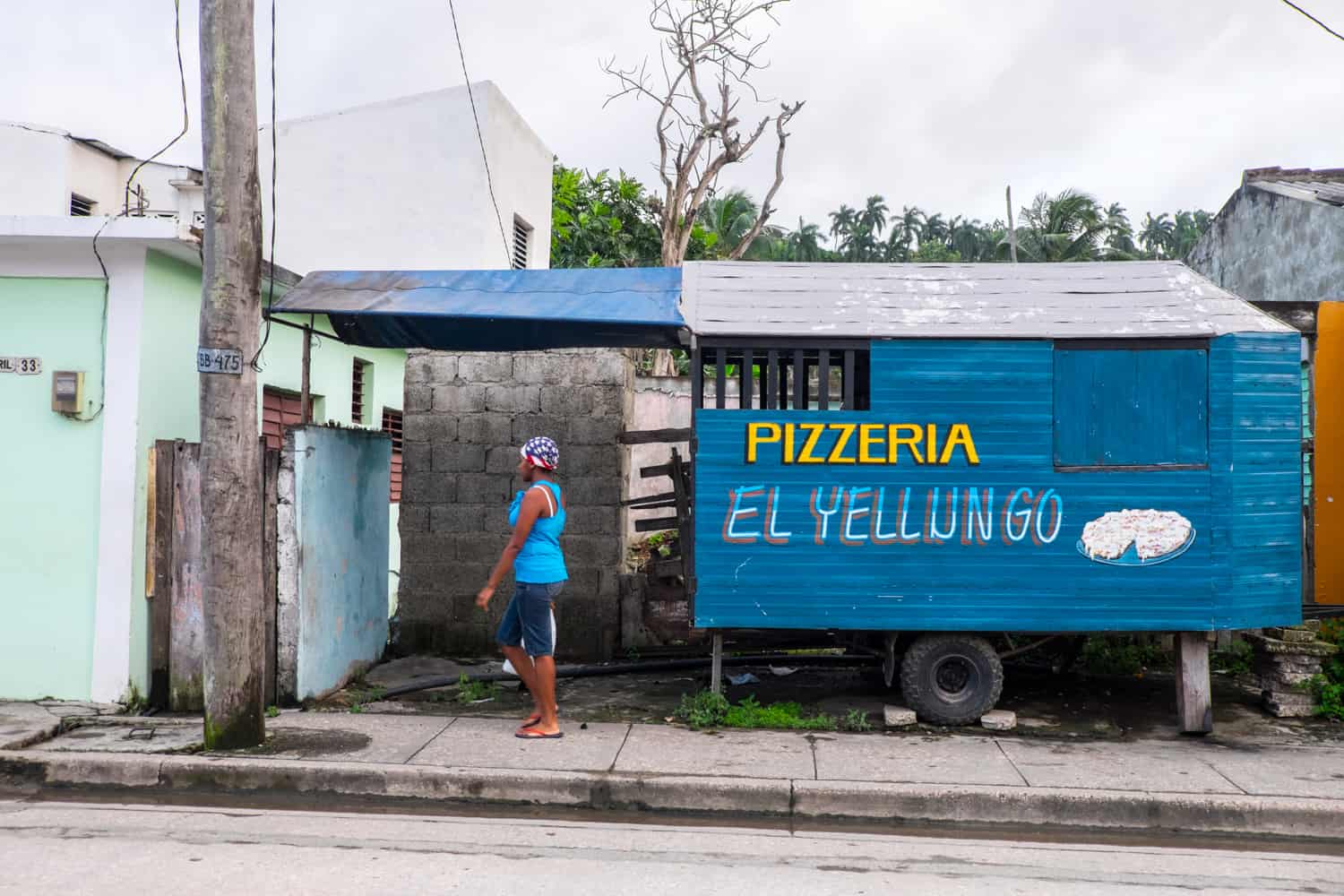
Peso pizza hut in a Cuban neighbourhood.
Flying to Cuba
The best way to get to Cuba is by one of the many regular flight options, and you will find many have to connect stateside. Depending on your starting country, you will likely have to transfer via the US or Canada.
Flights to Cuba from the US
On 31st August 2016, the US Department of Transportation announced that only 20 daily non-stop flights would operate from the US to Havana, 14 of which will be from Florida. Operators that fly to Cuba from the US include:
- Alaska
- American Airlines
- Delta
- Frontier
- JetBlue
- Southwest
- Spirit
- United
Flights costs from the US to Cuba vary, but you can find deals for as little as USD 99 each way.
Flights to Cuba from Canada
Even if you live outside North America, your flight to Cuba will likely route through Canada (as mine did from London) if you choose a budget option. WestJet is one of the leading carriers with regularly scheduled commercial flights to Havana and Varadero. They also allow you to have a ‘split vacation’ where I could spend some time in Canada on either side of my Cuba travels.
My return flight from Canada, on the Toronto—Varadero route, cost around CAD 250.
The cost for a return flight from Toronto to Havana is a similar price.
Flights to Cuba outside of North America
Some of the main carriers offering flights to Cuba from further afield, such as Europe (likely with one stopover), are:
- Air France
- KLM
- Air Canada
- Finnair
Return flights from European hubs start from around €700.
Preparation for Independent Travel
First, let’s talk about how big Cuba is. It comprises 15 provinces spanning over 110,000 square kilometres, and getting from one end to the other of this long island is a journey of over 1,100 kilometres!
Destinations may look close to one another on a map but can take many more hours than imagined. Getting to Cuba is the easy part, but travelling around Cuba independently means getting from A to B on the ground isn’t always straightforward – you can’t plan your days according to rigid timetables.
- Roughly plan what parts of Cuba you want to visit on a map you can carry, like this laminated, pocket-sized folding map of Cuba by StreetSmart. The StreetSmart Havana map is also an excellent addition for those wishing to dig deeper into Havana.
- Highlight the places you want to visit and start planning your first two or three stops. It’s hard to plan beyond that since you can’t always get the bus tickets where and when you want.
- A Cuba travel guide map is helpful for switching routes and seeing where the nearest city is or the next best place to pick up a bus or a shared taxi. I got mine from the Auténtica Cuba tourism guide at a travel show, but they have a detailed digital map that’s also useful for pre-planning before you hit the ground. Our plans changed so many times that I lost count, but we quickly devised a plan of action by referring to ours.
- The Cuba Lonely Planet guidebook was handy for scribbling down points of interest and having a quick referral when booking transport and making last-minute plans.
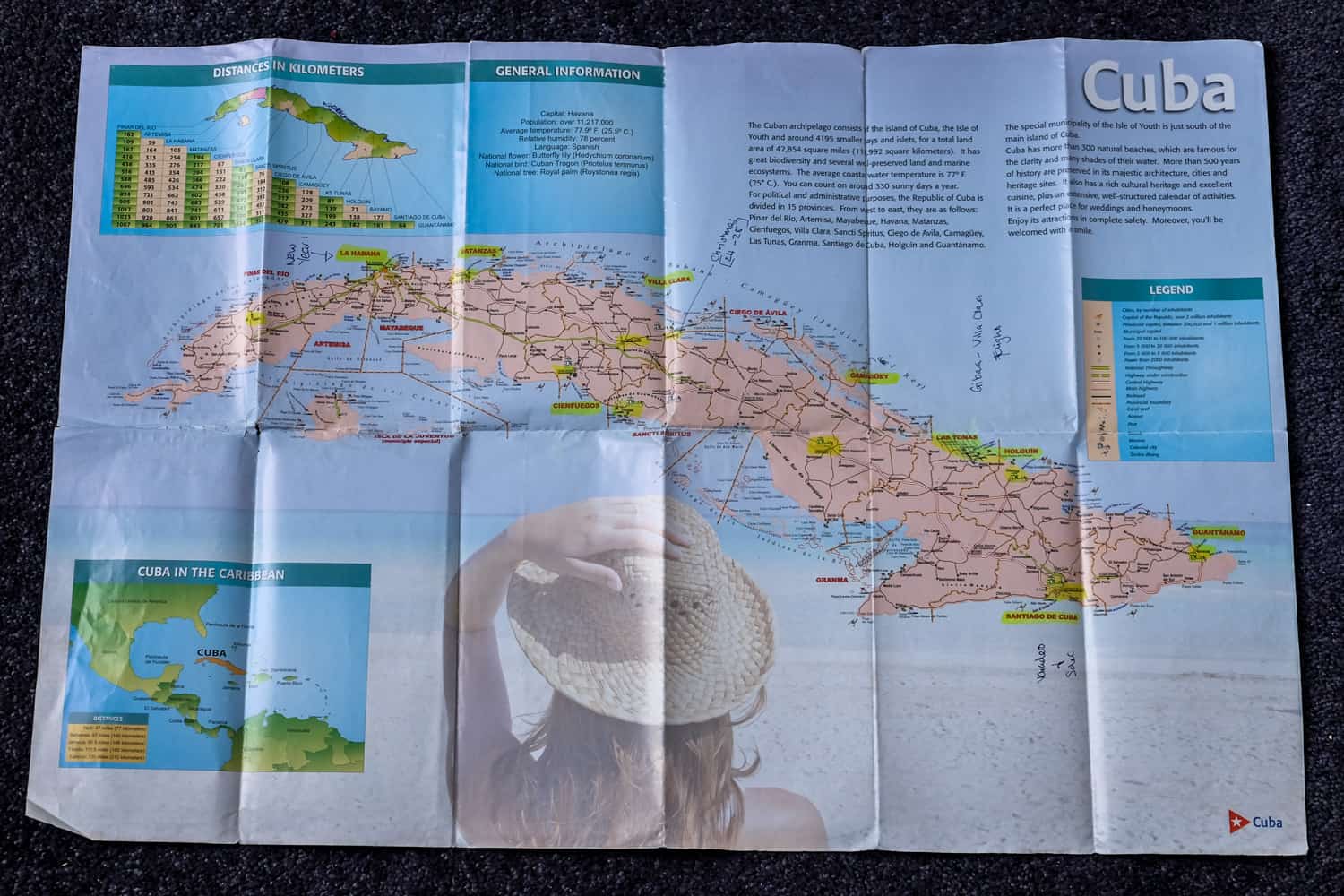
A map of Cuba is helpful for planning which destinations to visit and how to get around.
Where to Go in Cuba
Many first-time visitors focus on Havana, Varadero, Vinales, and Trinidad. These destinations are near Havana and typically easy to reach, with frequent transport routes and options.
We planned to travel all over the country, and it got tricky.
We wanted to catch a bus from Varadero that makes its route down the National Throughway road towards Santiago De Cuba in the island’s east. That would be the easiest route across the country, and over four weeks, we would make our way back, stopping at various destinations along the way.
Except you are at the mercy of limited transport and tickets.
While in Varadero, we couldn’t get a bus ticket for Santiago De Cuba for days. That meant not even being able to get a ticket to Santa Clara along the way, from which we could easily get to Cienfuegos and Trinidad before venturing eastwards.
Expect to change your Cuba destination plans constantly.
We changed at the last minute to a different bus route that would take us from Varadero to Cienfuegos and Trinidad. Then, when the time came in Trinidad to move further east, we couldn’t get a bus. We were told we must return to Cienfuegos to travel to Santa Clara.
With the help of locals who live these frustrations, we found an answer. We took a taxi to neighbouring Sancti Spiritus, where we picked up another bus on its way to Santiago de Cuba. From there, we travelled to Baracoa at the very end of the island, where we formulated a new plan and worked backwards towards the capital, taking in the cities on the main National Throughway road: Baracoa—Camagüey —Santa Clara—Havana.
The route, in short:
Varadero > Cienfuegos > Trinidad
Trinidad > Sancti Spiritus > Santiago De Cuba
Santiago De Cuba > Baracoa
Baracoa > Camagüey > Santa Clara > Havana
Havana > day trip to Matanzas
Havana > Vinales > Varadero
Ask locals. Go to the bus offices in person.
There is no one ideal way to travel here. Don’t plan too much; be prepared to roll with the punches and go where the adventure leads you.
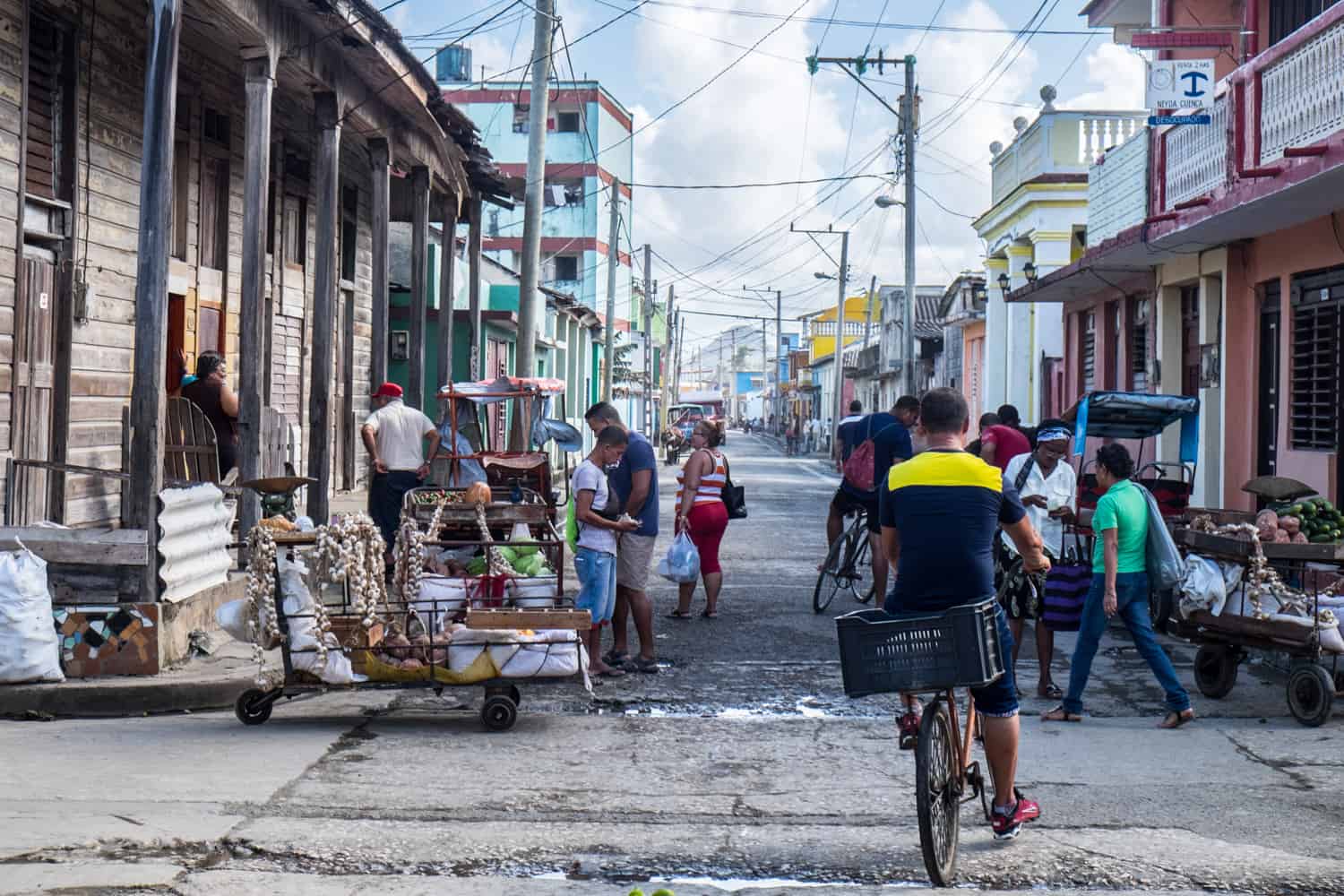
Small food market in a neighbourhood in Camagüey, Cuba.
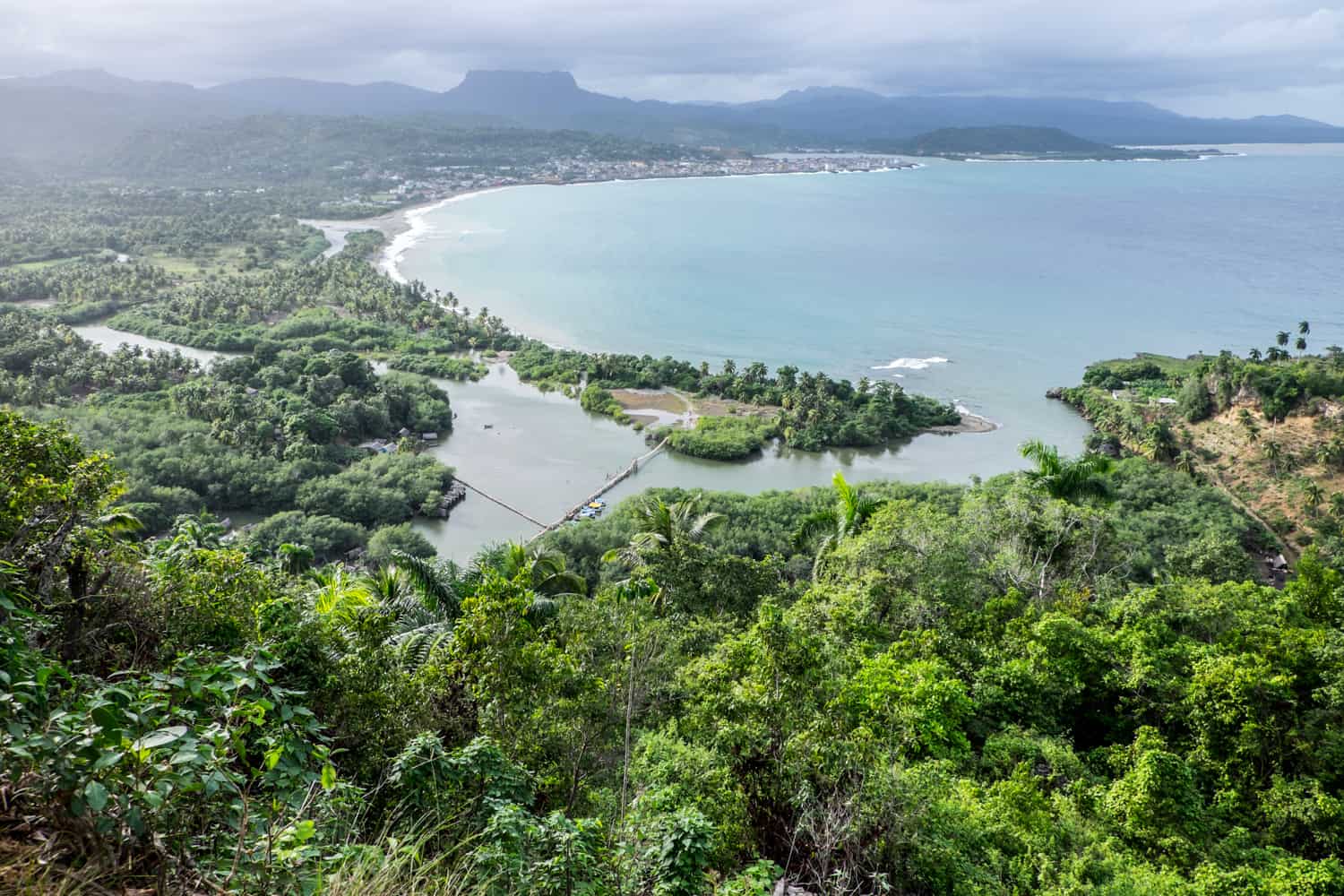
The port city of Baraoca is the capital of the Guantánamo Province in eastern Cuba.
Currency and Money in Cuba
One Cuban Currency – CUP
When you arrive in Cuba, the first thing you need to do is secure a reasonable sum of cash for your trip.
In January 2021, the tourist Cuban Convertible Peso (CUC) was removed from circulation.
This means the Moneda Nacional / Cuban National Peso (CUP) is now the sole legal cash currency in Cuba.
This Currency website has further information on Cuban money, notes differences, and current exchange rates.
The Former Dual Currency System
Before 2021, Cuba’s dual currency system was always tricky. Tourists were not supposed to use the local Cuban Moneda Nacional CUP because having an imposed form of currency to use meant visitors could be charged inflated prices (governments largely run businesses, and local people are heavily monitored). It was not illegal, nor was it impossible to dabble in local currency. The likelihood was that it was hard to exchange CUCs for CUPS and find people willing to take CUP since the CUC was worth more to them.
Spending Wisely
Before 2021, National Pesos / CUPS could be used at local markets, street stores, local Cuban food shacks, and Collectivo taxis. The standard price for using the toilet is 1 CUP, so keep 5 CUC cent coins handy for those moments. Today, it will be even easier to spread your money where it matters more.
Spending local money became a joy, not only because it made a standard expensive Cuba trip more budget-friendly but also because we could find boxy stores in quiet neighbourhoods and hole-in-the-wall vendors where we could hang out with the locals.
We would exchange money with local friends or the Casa owners and save every National Peso coin we were given as change when paying for something in CUCs where exact change couldn’t be given.
One of my most treasured memories was stumbling upon a small shop on a backstreet in Trinidad. My friend and I spent two hours eating ham sandwiches and drinking Cuban rum and coffee before buying wine and cigars to take away. Our afternoon set us back around $10, just under half of what a Cuban makes in one month. We got to experience the real Cuba and give back to a local business directly.
A Cuban friend in Santiago de Cuba took us to a restaurant inside a house – a place with no sign and known only to locals. This was a unique experience and certainly attributed to being with someone who knew about it and could get us in.
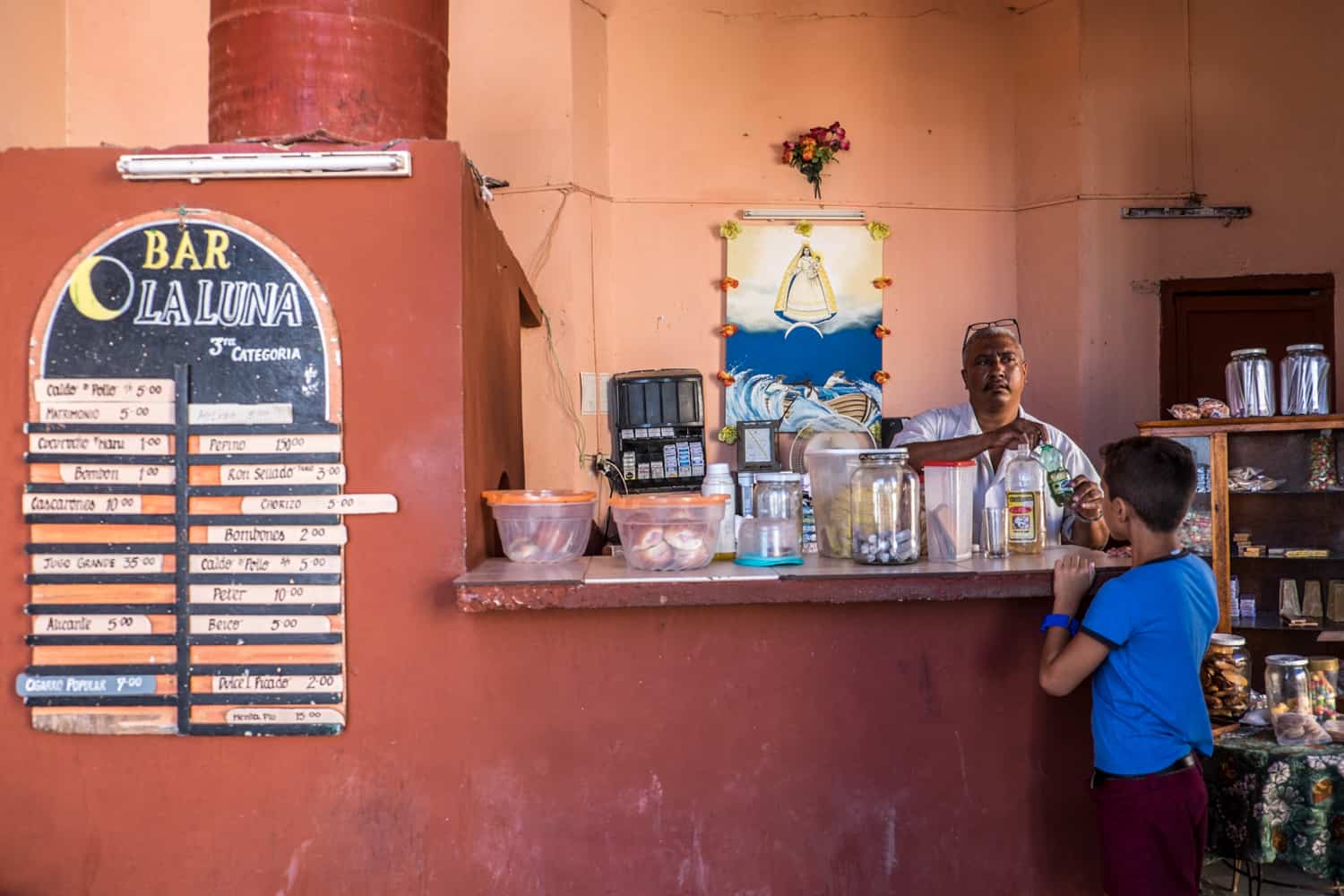
Spending local money (CUP) at smaller, locally-owned stores.
How Much Does it Cost to Travel in Cuba?
Despite Cuba being Socialist, high prices are enforced across the country, where capitalist commercialism and tourist prices are in place for visitors making it relatively expensive.
It’s a contradiction, but don’t assume a trip here is more affordable just because it is communist – one of the world’s few remaining communist states alongside China, North Korea, Laos, and Vietnam). While prior tourism in the country was for visitors flocking to Cuba’s coastal resorts on all-inclusive packages, over the years, a chaotic and inflated pricing system has sprung up all over.
Most local restaurants will even hand you a specific tourist menu – one with fewer options and incredibly inflated prices. This also means you are likely to be ripped off often, especially where pricing isn’t transparent regarding the former tourist CUC and the local CUP pricing system. Black markets were in full force for locals, who often had to pay former tourism peso prices for luxury goods.
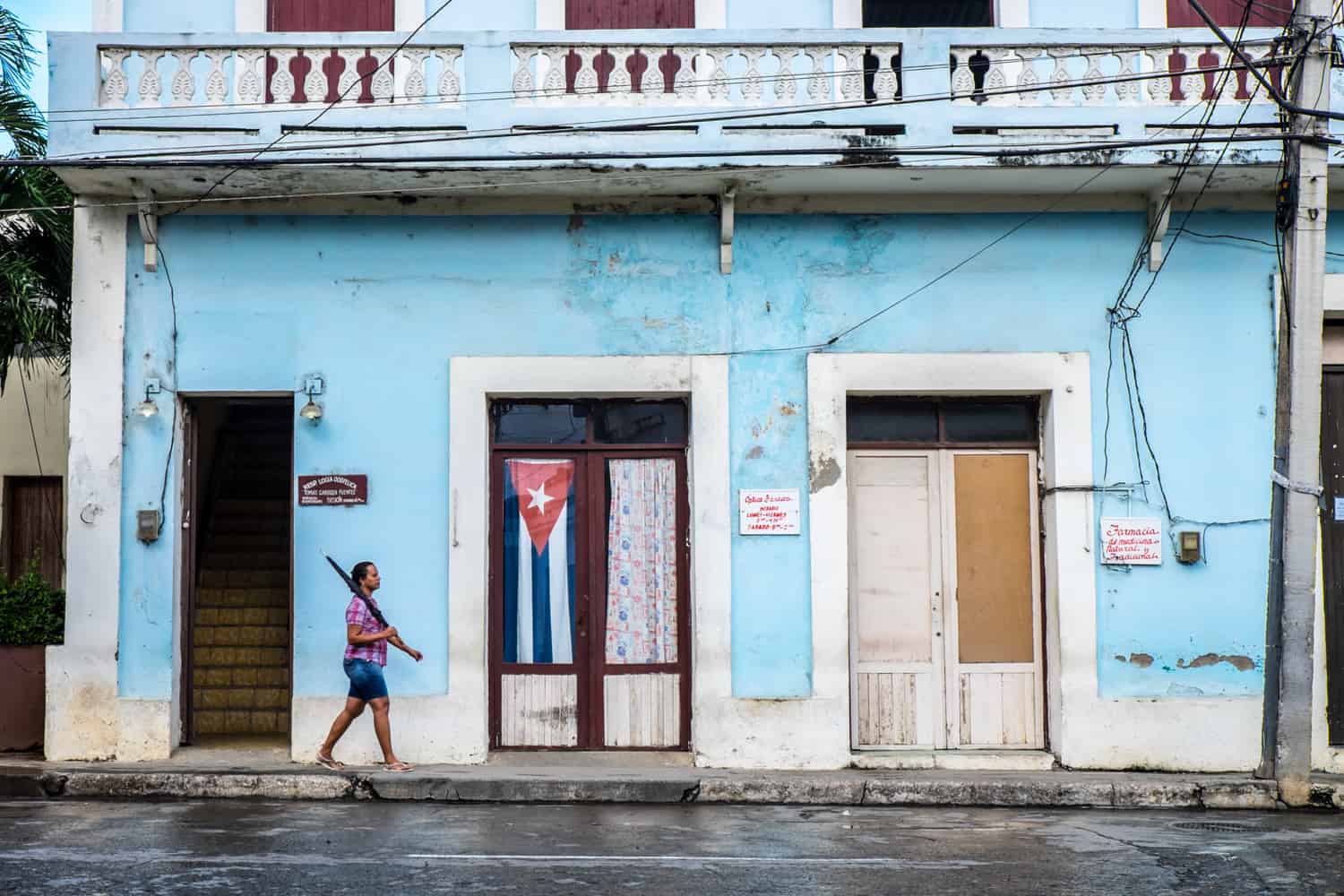
How Much Does it Cost to Travel in Cuba? It’s not as budget as you think.
Overall Costs of a One-Month Trip to Cuba
Backpacking in Cuba is not as budget-friendly as in Asia, but it can be if you watch your expenditure.
In one month, I spent €1500, plus €700 on flights from Europe to Canada and internally from Toronto to Cuba.
Our average daily budget in Cuba was $50, including food, accommodation and entrance fees.
Exchanging Money – Banks and ATMs
We brought in a mix of US Dollars, Canadian Dollars, and Euros and changed them at Casas de Cambio SA (CADECA) banks all over the country.
I took 700 US Dollars and 500 Euros in hard cash, but it was far from enough. I ended up withdrawing over $1,000 from ATMs in four separate transactions.
You’ll find ATMs all over, including in the small town of mountainous Vinales, but individual ATM fees apply, so it’s best to carry as much hard cash as possible.
Standard Travel Costs in Cuba
Accommodation Costs: $25 per room per night in Casa Particulares (see below). An extra $5 is charged for breakfast, and a meal at the homestay will set you back around $25.
Food Costs: You can spend anywhere between 20 cents on a local ‘Peso Pizza’ or ham sandwich to $15 on a three-course meal at a local restaurant.
Drinks & Alcohol Costs: A spirit and mixer could cost $5 in some bars, and beers are a little cheaper. We found it cheaper to buy a bottle of rum for the same price (or beers from the local store), which we often drank on the street and shared with locals: cue guitars and lots of sporadic singing and dancing. A one-litre bottle of mineral water should cost you less than $1.
Cuba Sightseeing Entrance Fees: You will notice the inflated prices between the tourist entrance fee and the local fee at museums and sites of historical interest. A former 4 CUC entrance for visitors was only a 4 CUP / National Peso price tag for locals. That’s $4 vs less than $0.20 for locals – over 20 TIMES the price. However, this is still affordable for a visitor compared to a Cuban.
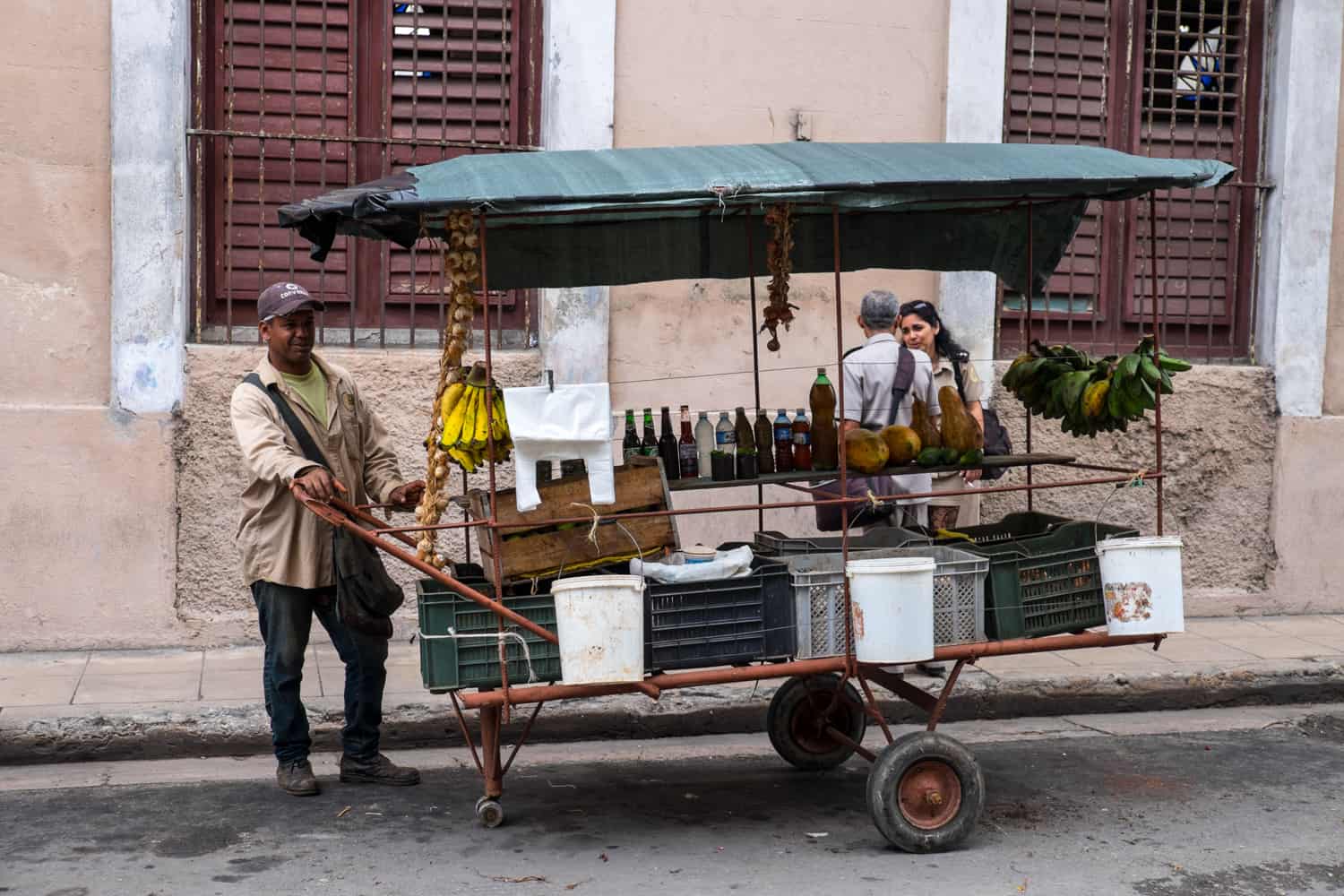
How much do things cost in Cuba? Who knows if the single currency will level out inflated pricing.
Extra Costs
Buses: Ranged from $11-$25 one way
Taxi hire: Prices for day trips worked out between $40-$60 for a round-day trip
Collectivos: Set prices ranging from $10-$20 depending on the distance. Find out the set price from locals before embarking on the trip.
Local buses: You can catch local buses to the beach in towns close to the coast (such as Trinidad) for around $2.
Internet cards: A one-hour card costs $2, and a five-hour card costs $10. See below for further information.
Airport Departure Tax: Keep $25 aside when you leave.
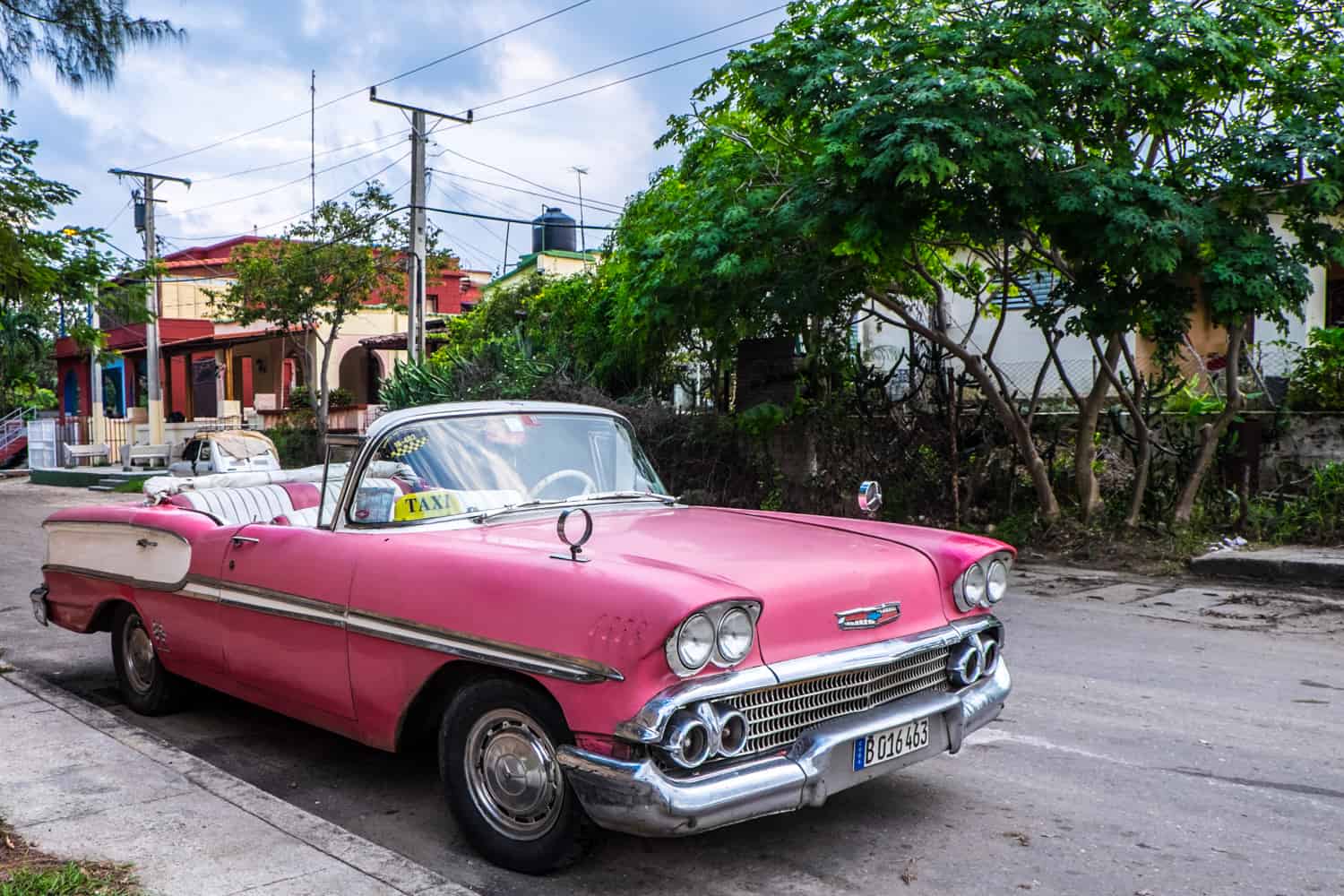
A classic Cuban car taxi.
Where to Stay in Cuba
Casas Particulares – Live Local
A Casa Particular is a Cuban homestay and the best and often the only option, especially in smaller towns. You occupy a bedroom in a local house transformed into a little guesthouse. Usually, you get a private bathroom or share it with the family.
The beauty of living at a Casa is having a local on hand to help you and being right in the centre of each destination where the Casas are often situated. Just be prepared to live simply.
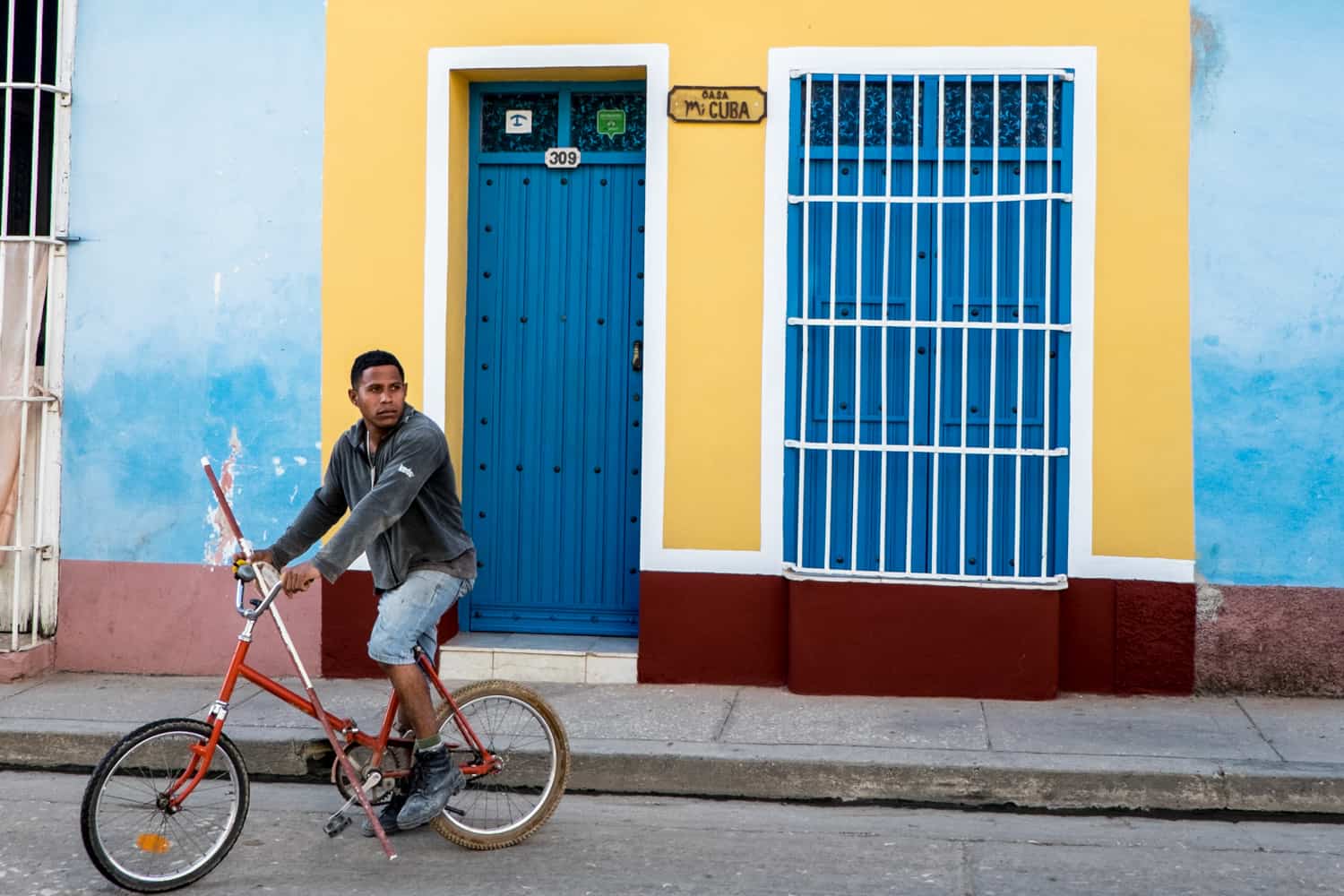
A typical Casa Particular in Cuba.
Don’t be alarmed when handing over your passport at each Casa Particular. The owners of the Casas in Cuba have to apply for a special government license to operate this business, log each visitor, and declare all income every day.
Despite this, your money is directly in the hands of the locals, even though they have to pay high taxes.
Some of our Casa Mama and Papas made us dinner for an extra price (around $10) and a hearty breakfast of eggs, bread, fruits and coffee for $5. Meals are offered to you upon arrival to pre-plan what foods they need to buy.
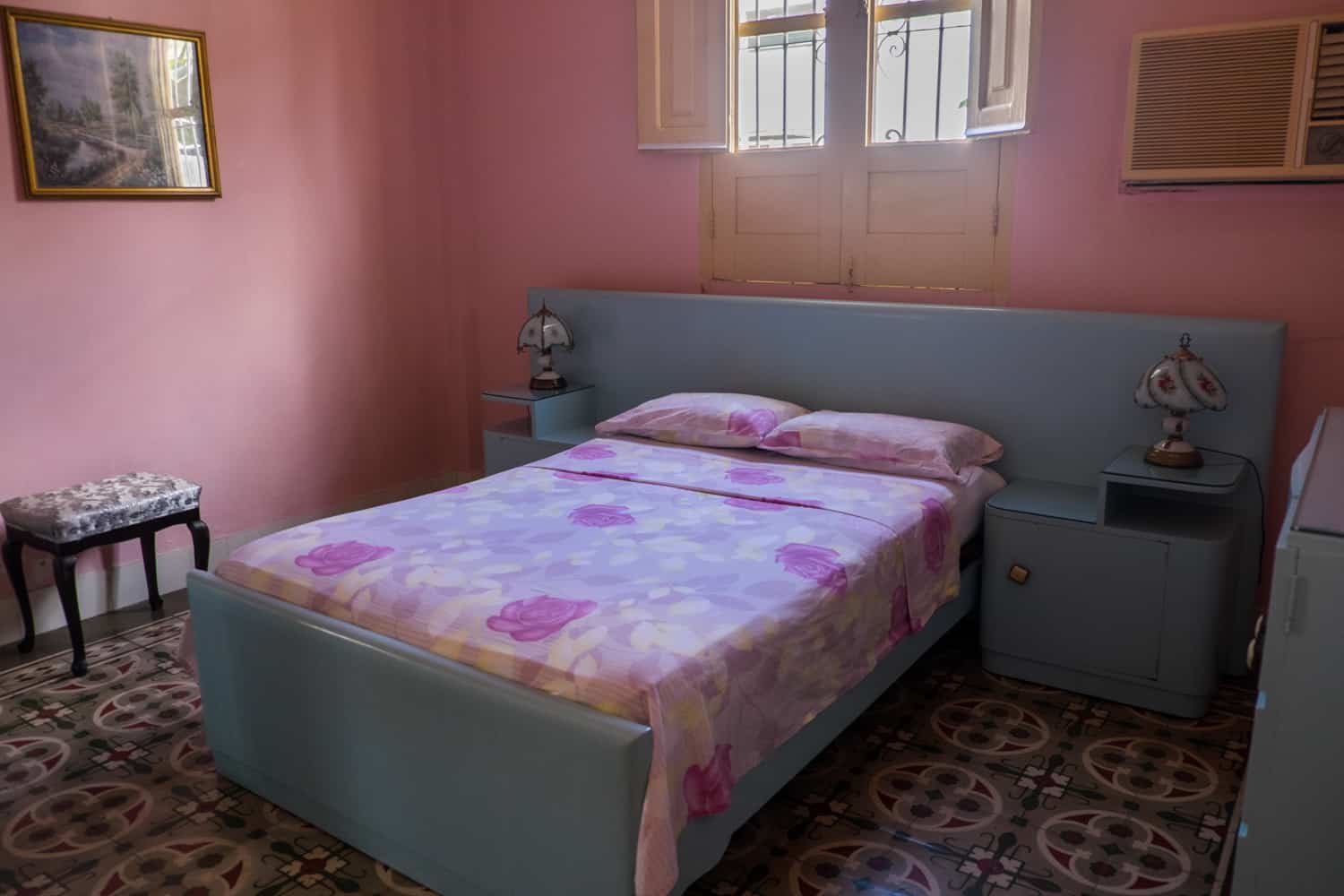
Cuban Casa bedroom.
We found our Casas on CubaJunky and called those listed in the Lonely Planet Cuba guidebook.
We largely took the recommendations of Casa owners who would call through to their contact (often family members) in the next city, who would be there waiting to pick us up.
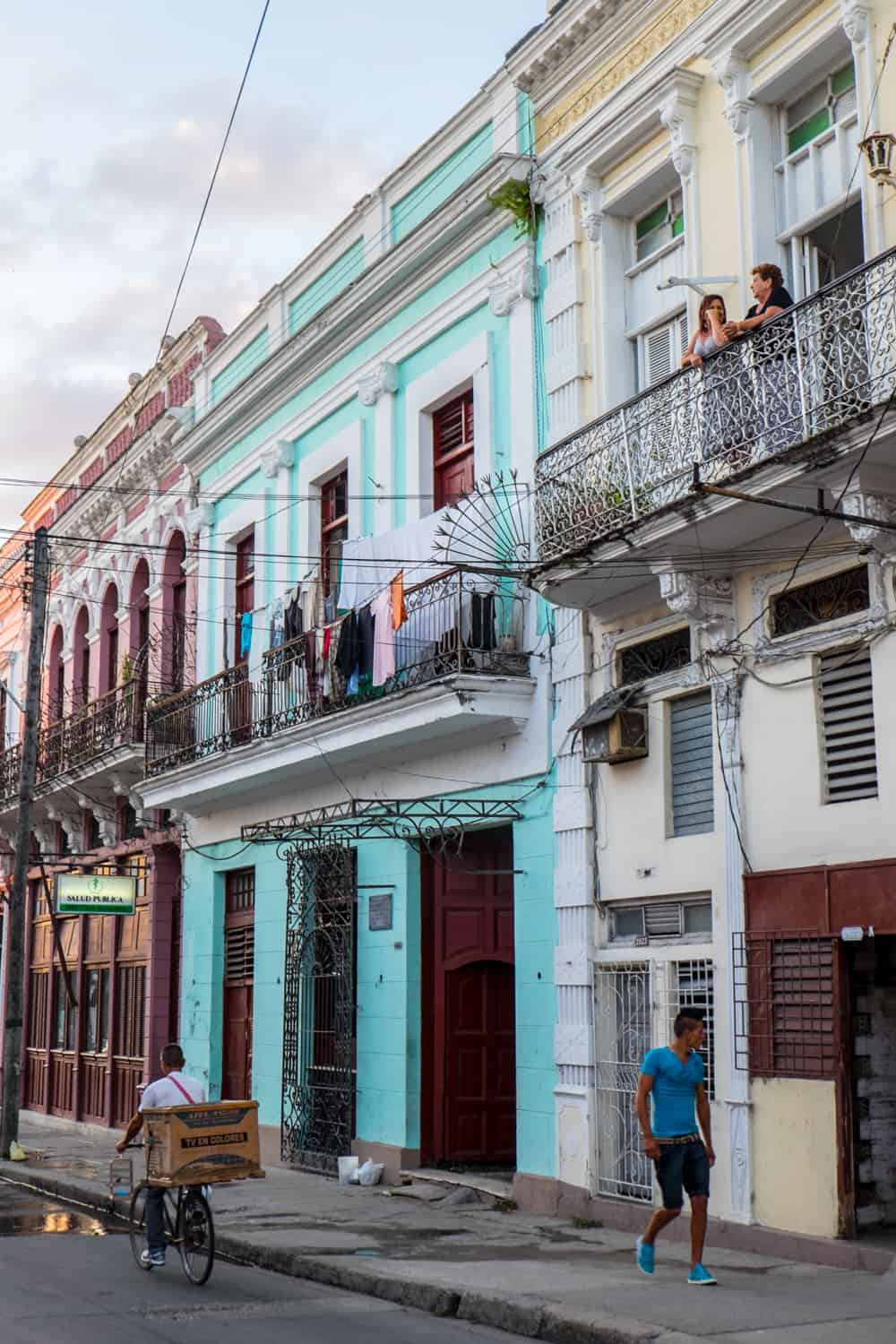
Residential life in Cuba.
Airbnb in Cuba – Sporadic
Airbnb now operates in Cuba, although only in Havana and Varadero.
Hostels in Cuba – In Major Cities
Outside the well-entrenched Cuba resort set-up, there are few options for traveller-style hostels in Cuba. However, there are some larger Casas with multiple rooms and some with dorms. You’ll likely find these in Havana, Trinidad, Santiago de Cuba and Varadero with budget options and places close to nightlife.
Solo Travel vs Tours in Cuba?
Many visit Cuba without a tour, but others like to strip out the frustrations that come with it.
Are you unsure about independent travel in Cuba? Would you prefer a route plan to be taken care of and travel in a small group with fellow adventurers? I recommend this 15-day Cuba tour with G Adventures, which covers the country’s key cities in a big loop from Havana to Baracoa, or this 8-day biking tour for an active trip.
This option means ditching the traditional tour guide in Cuba method and having a Cuban local facilitate your trip and help to navigate the trickier parts of getting around Cuba.
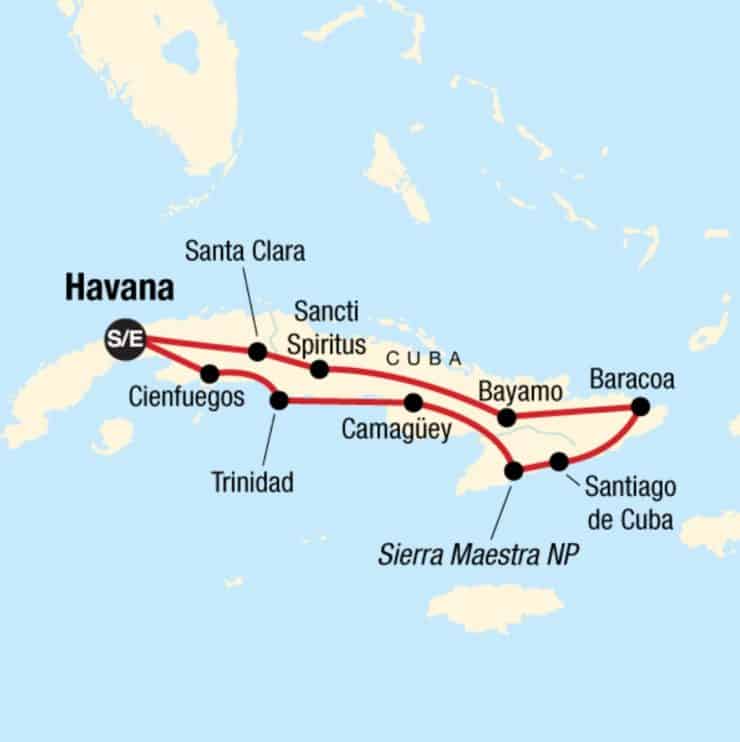
Map of a Cuba tour route.
Is Cuba Safe to Visit?
Travelling in Cuba is considered to be safe, even for independent travellers. Petty crime, pickpocketing and scams in Cuba can be common but easily avoided by being streetwise.
The only bad attention we ever encountered was from professional street beggars who got aggressive when we said no, and from a local we were hanging out with one evening who continuously asked us for money.
Keeping safe in Cuba is more about dealing with the direct interference you will encounter – opportunism.
There are no particular rules for travelling here, but you should always make sure you are well prepared for any trip via the advice given by your foreign office. If you plan to explore isolated parts of the island, especially on long treks, it’s always best to go with a guide who knows the area well.
Be sensible, and don’t walk down poorly lit streets at night. And if you’re staying out late in Havana, keep to the very centre, as there are often police in the most frequented areas.
Before your visit, make a copy of your passport, insurance documents and other vital documents and keep them safe throughout your trip.
Cuba’s ‘Committees for the Defence of the Revolution’
Even now, Cubans live under a system of surveillance that you will see by the hand-painted CDR signs on houses, walls and fences in every neighbourhood you walk through.
CDR stands for ‘Committees for the Defense of the Revolution’ – a form of secret police that monitors people’s livelihoods and actions. Others argue it is a force for social good that brings the community together.
The CDR, however, is not in force for travellers, nor will it affect your travels in the country.
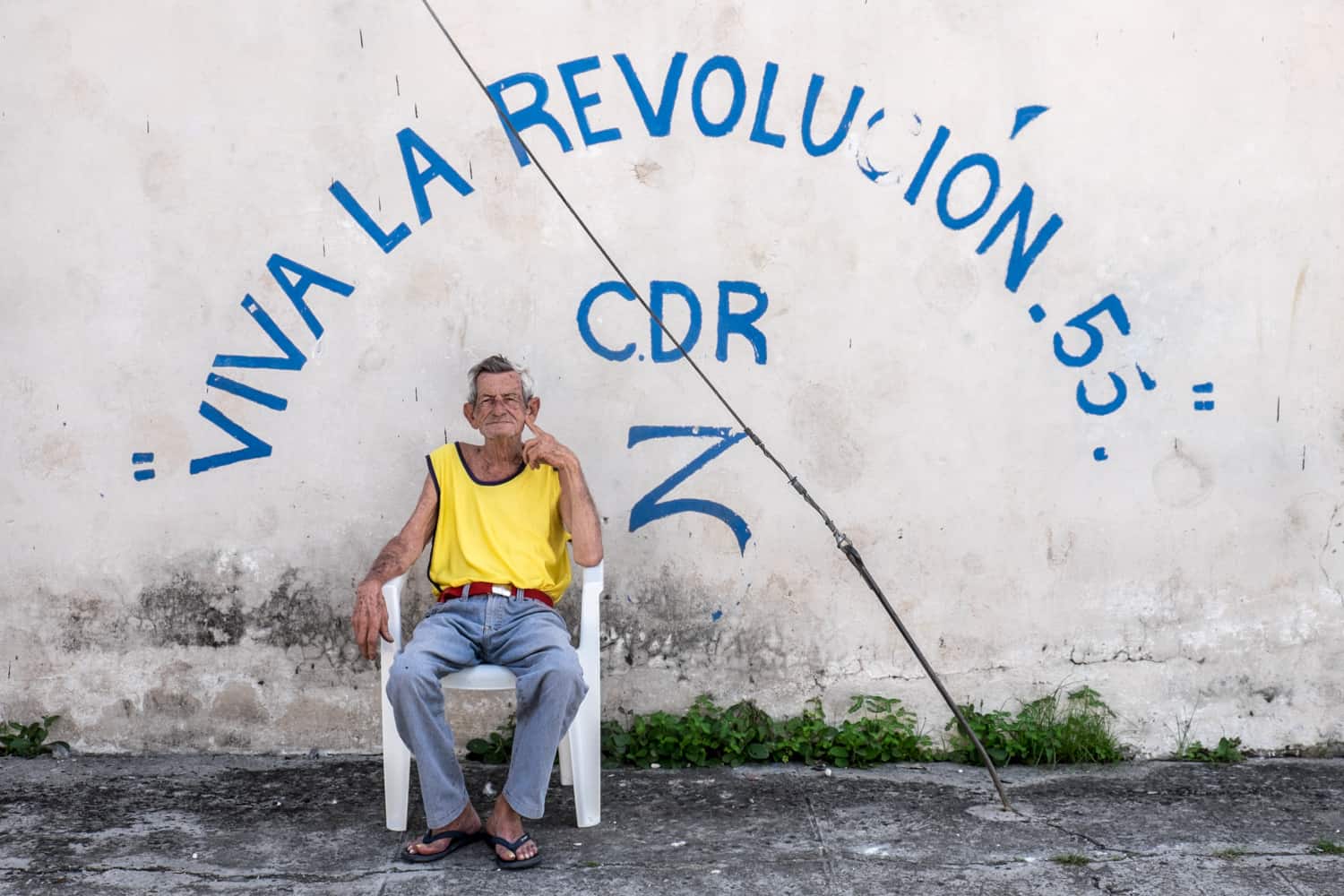
A CDR neighbourhood sign.
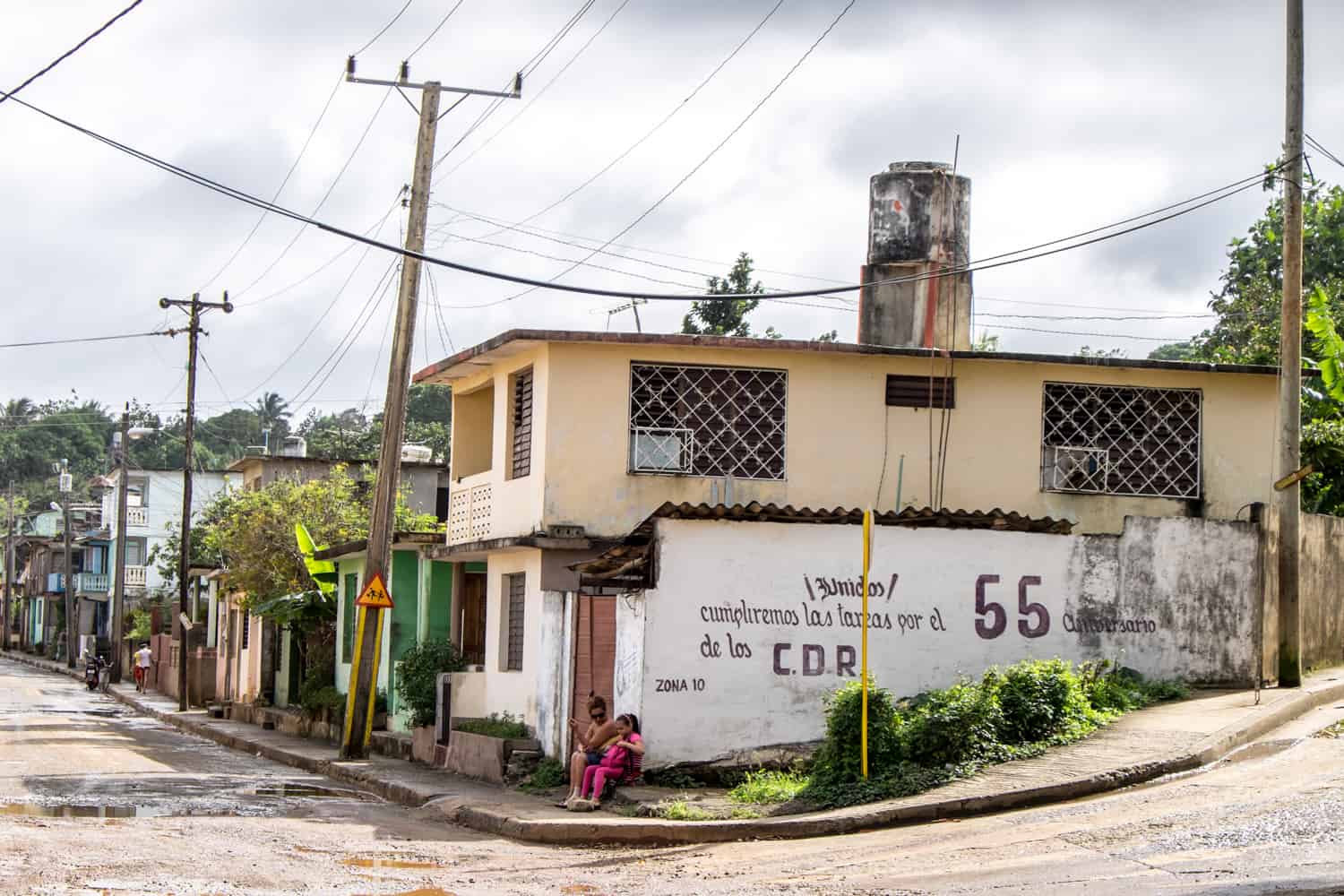
CDR street numbers in residential neighbourhoods of Cuba.
Solo Female Travel in Cuba – You Will Get Attention
It’s safe to travel in Cuba as a solo female traveller, and it is in no way dangerous. The issue of attention is the most frustrating thing you will encounter here, and travel safety in Cuba rests upon keeping your wits about you. Cuban men are open, and the culture passionate, and it is not uncommon to hear wolf whistles or be the subject of unsubtle looks and glances.
I walked around the back streets of Havana on my own for days, and the best thing was to ignore it so as not to incite or give a false impression. Often you can answer back sarcastically, and it breaks the ice. Cubans live outdoors, with families hanging out on their street, sitting on the porch watching the world go by or playing board games. You are never really alone.
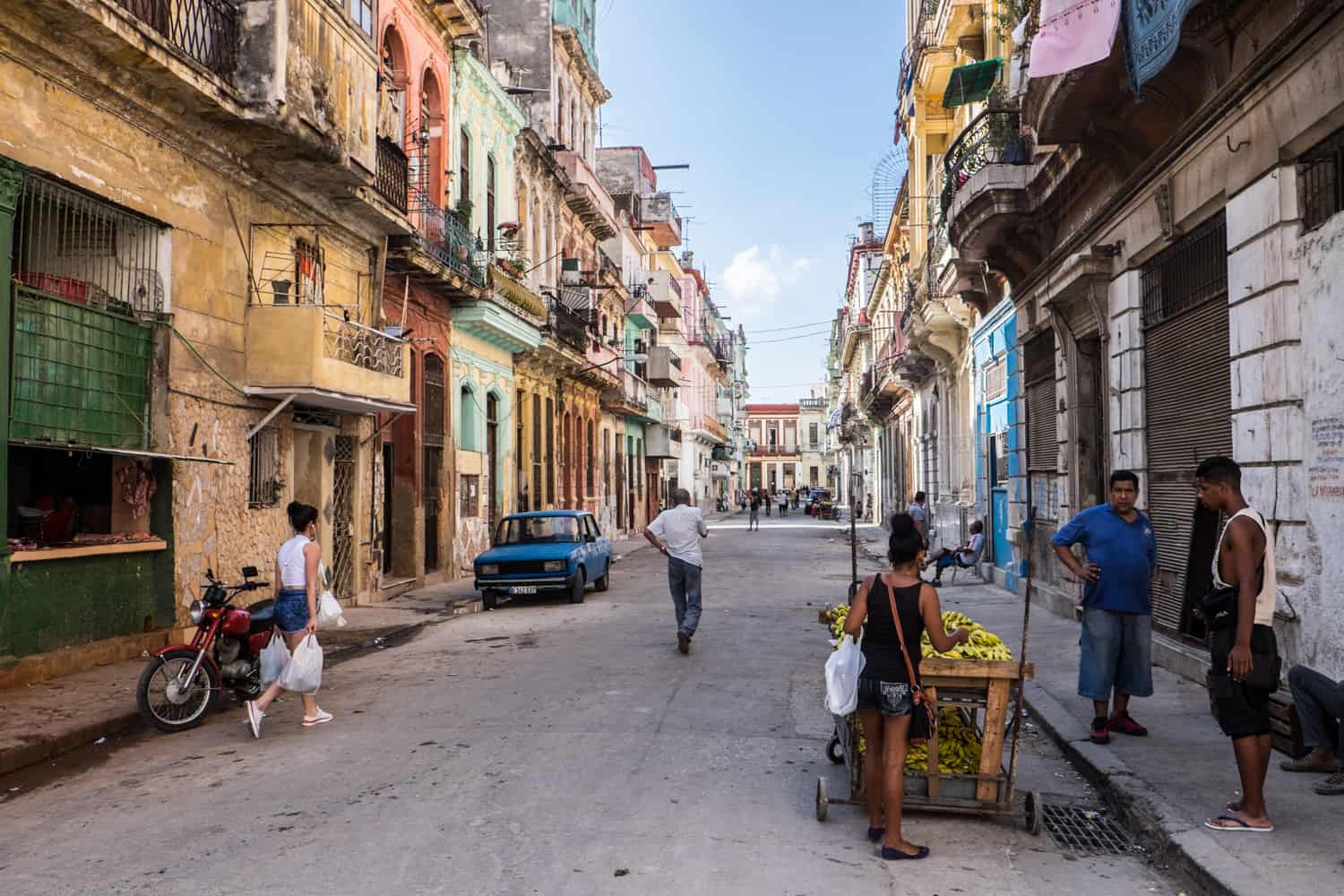
See Havana away from the tourist sites.
Don’t be alarmed if Cuban men come up to you and ask you to Salsa at evening events and street gatherings. Dancing is a huge part of the culture, often with no intention other than expressing yourself the way locals know best – music and moves.
Food in Cuba – Lower Your Expectations
Outside Havana, where international cuisine is prominent, Cuba is not a huge foodie destination.
Be Mindful of Rationing
Let’s not forget that this country’s citizens survive on rations. So always remember that as a visitor in a homestay, you are on the tail end of this, where supermarket and market offerings are limited.
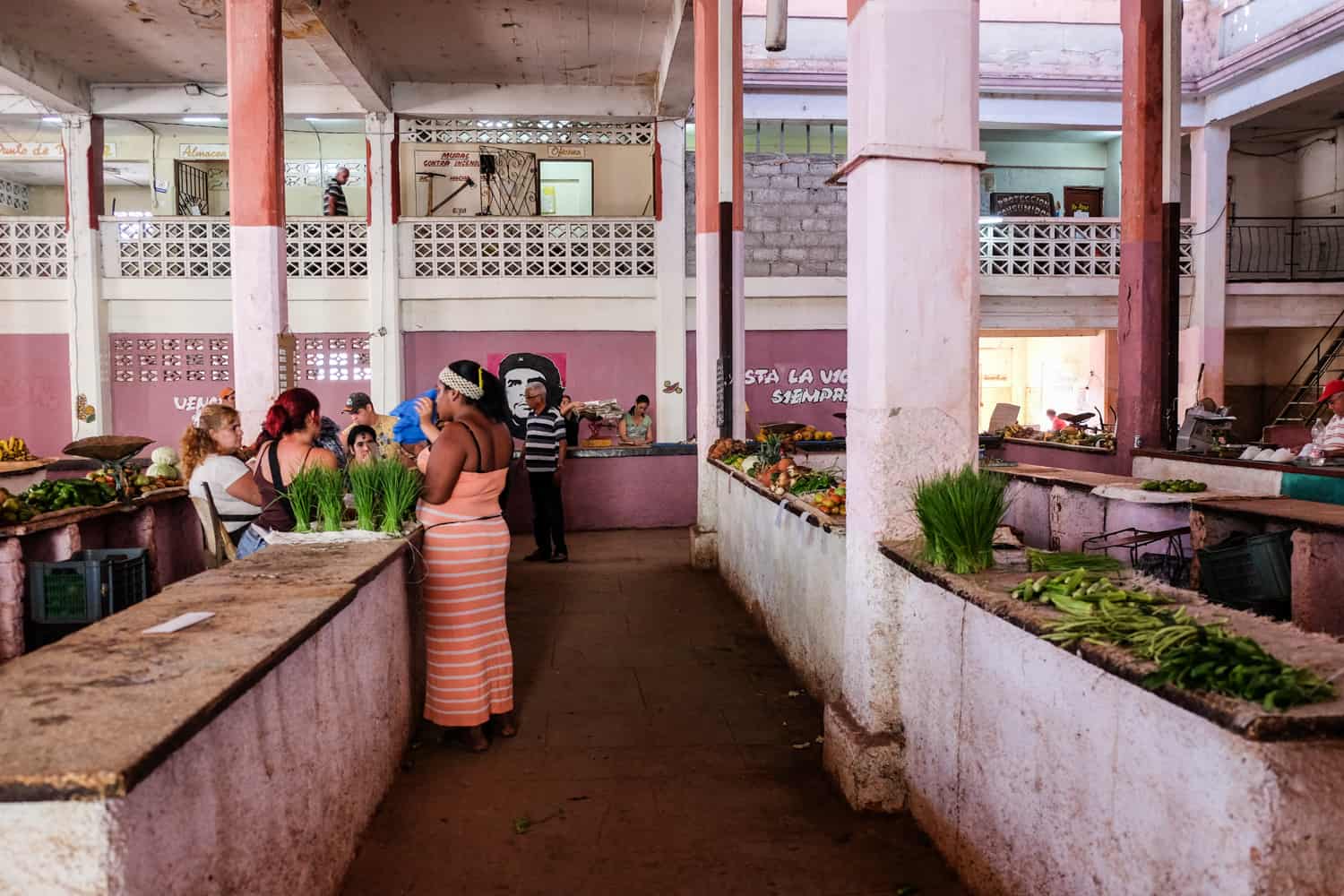
A market is Cuba, where an abdundance of food is hard to come by.
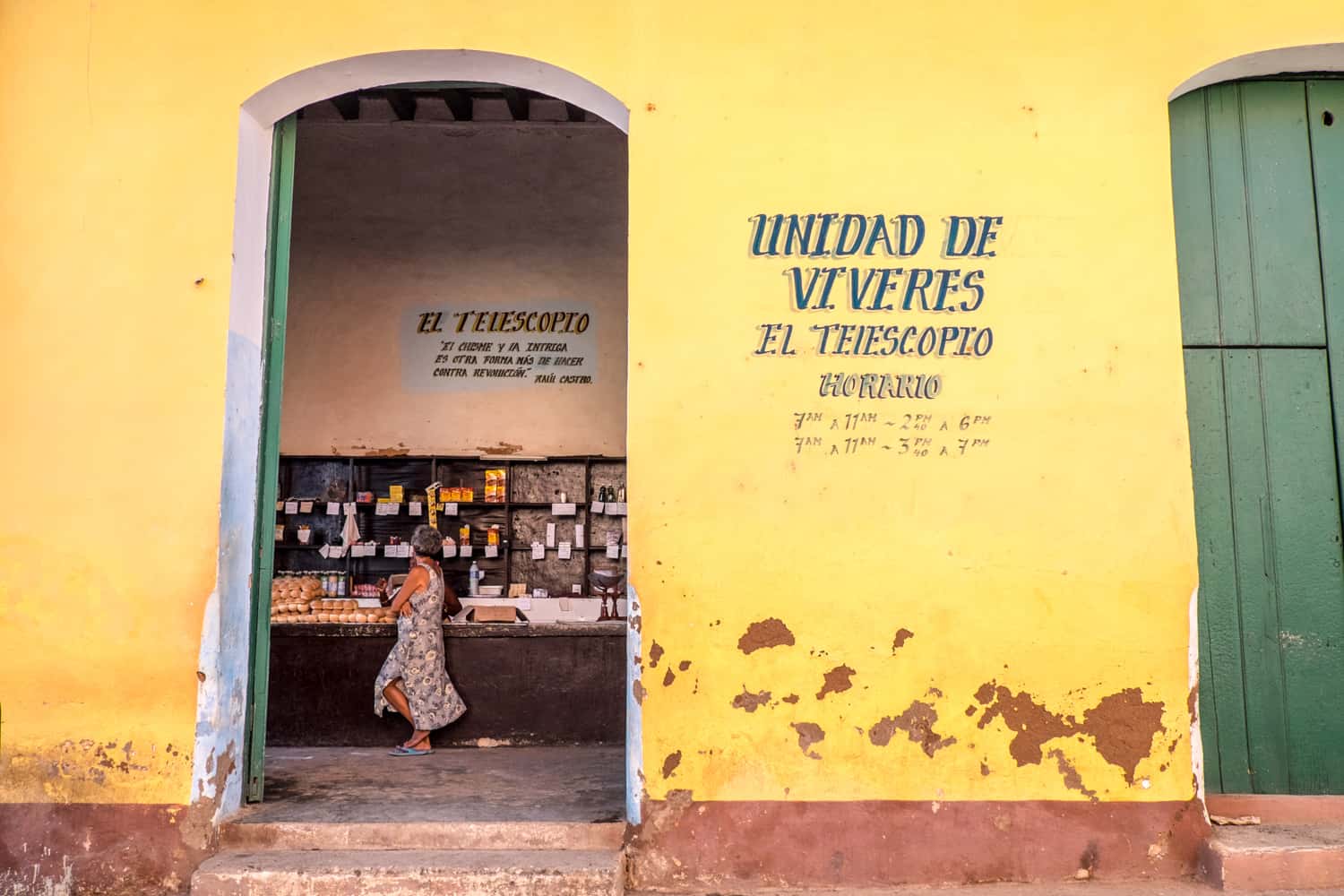
A woman inside a ration store in Cuba, with almost empty shelves of goods.
Cuban Food to Try
However, signature Cuban dishes to indulge in are:
- Ropa Vieja (shredded beef) – generally served with rice and fried plantains (the latter of which I never got bored with)
- Fresh Lobster – when on the coastal fringes of the country
- Arroz con Pollo – the simple but tasty chicken and rice best served from a local BBQ joint.
The Food at a Casa Particular
Breakfasts at homestays are usually an extra 5 CUC ($5) and are plentiful, consisting of bread and an egg, jams, fresh fruit and coffee. We often took some of it away for snacks. Casas on the coast offered Lobster for dinner, a real treat, with dessert and a glass of wine for around 10 CUC ($10).
Restaurants & Cuban Street Food
Paladares are house restaurants that are privately run from a family home. These are great for trying local dishes in true Cuba style and where the profit goes straight into local hands.
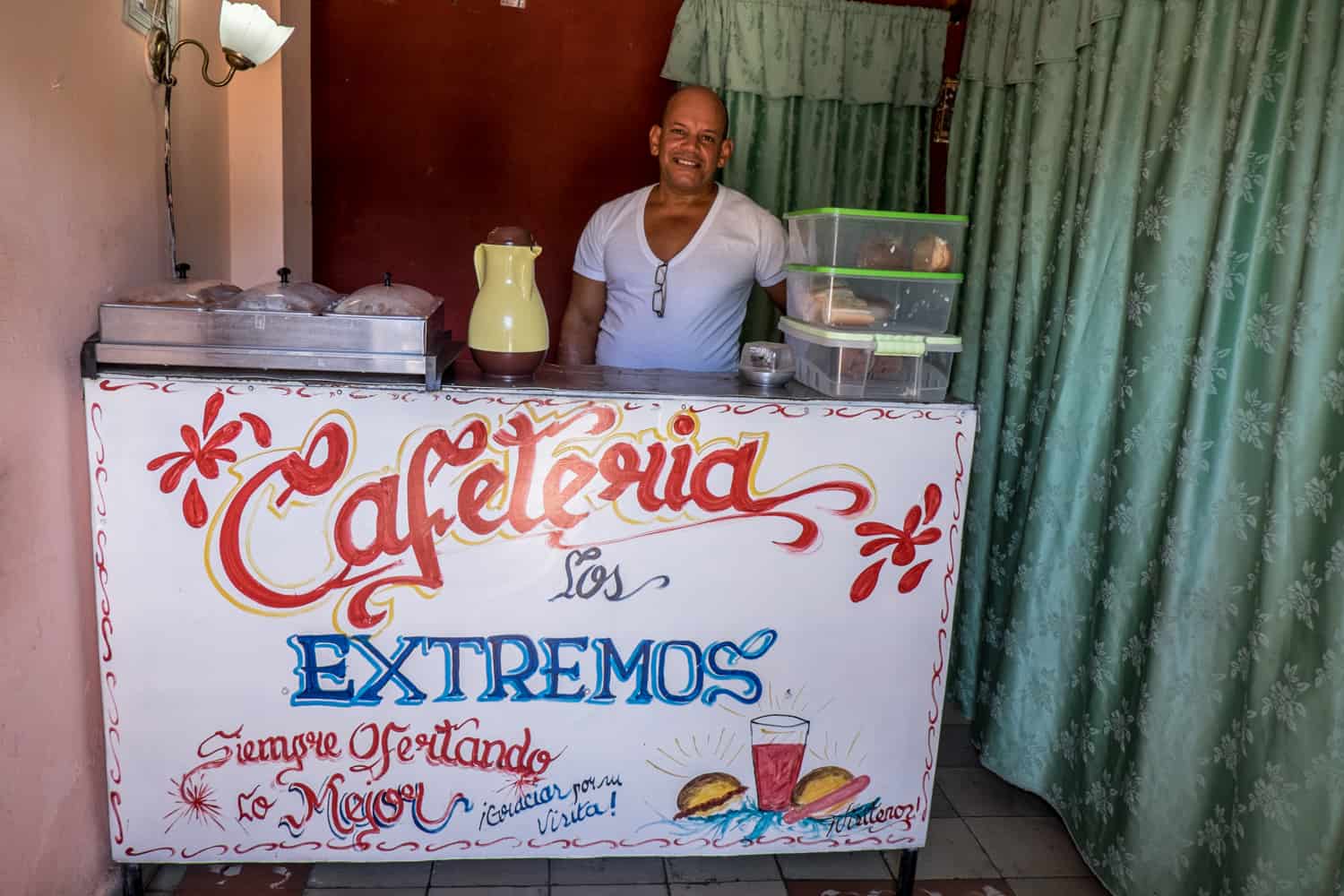
A local Cuban Cafeteria where you can get coffee and sandwiched snacks.
Look out for locals queuing at a hole-in-the-wall restaurant where you can pick up the infamous ‘Peso Pizza’ and local pizza and pasta places where you can get a meal for 1-2 CUC and save on budget. However, know that spam (processed ham) is a filler in most foods and can quickly get boring.
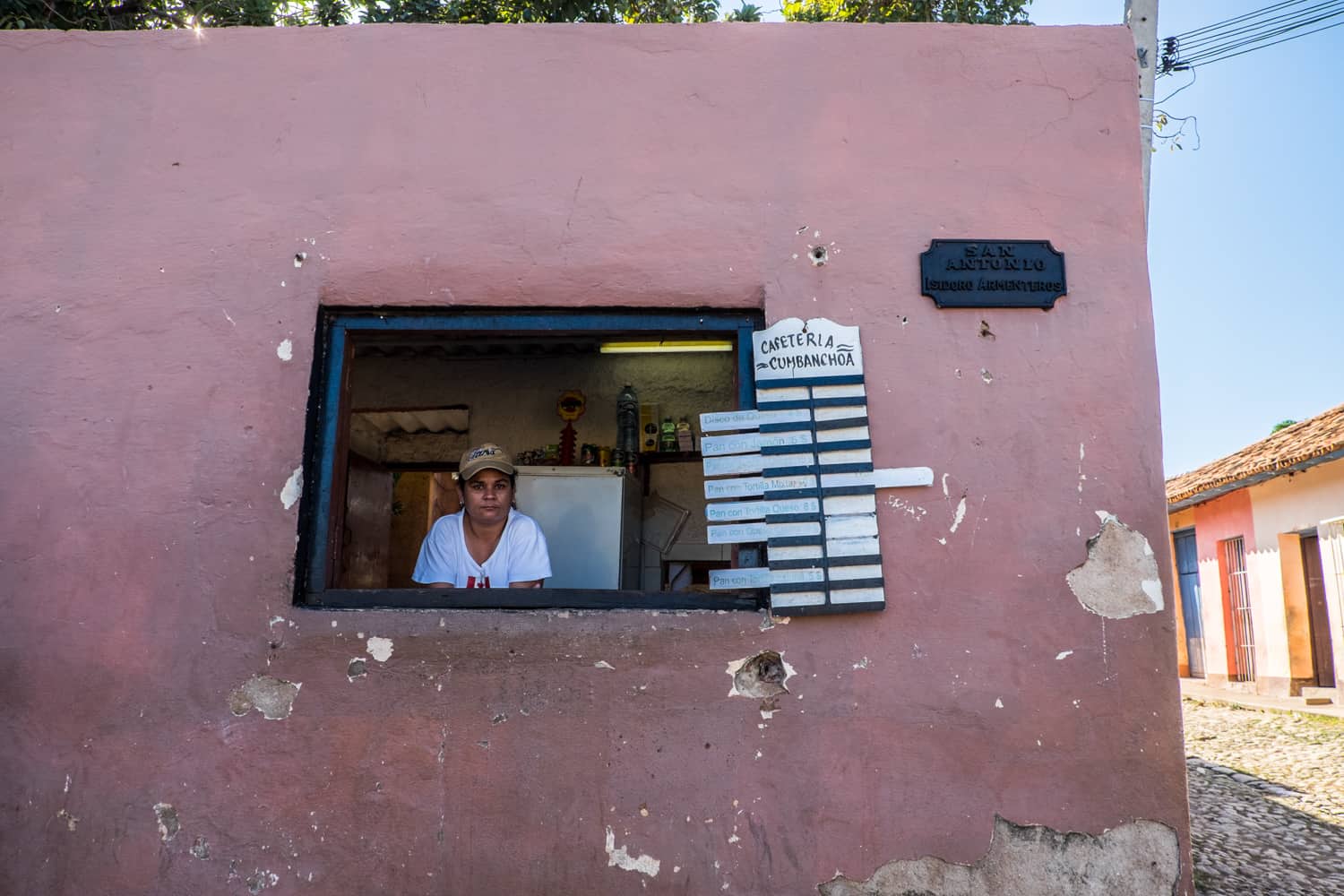
A local neighbourhood hole-in-the-wall Cafeteria in Cuba.
Cuban Coffee
Rum in Cuba is not the only liquid of choice since the Cafe Cubano is also a source of pride. You’ll often pass cafes and those hole-in-the-wall places where you can stand with locals and sample an espresso (also referred to as a Cuban shot) that will set you back no more than 50 cents to 1 CUP.
Read this beginner’s guide to Cuban coffee for a detailed overview of the Cuban coffee scene, Cuba’s coffee production, how and what to order and, more importantly, how to make it when you get back home.
You can also visit coffee plantations, purchase coffee beans from local producers, and visit the UNESCO site that remains one of the first coffee plantations in the southeast of Cuba.
Pre-Book Popular Restaurants in Havana
If you want to try out one of Havana’s restaurant highlights, or a venue putting on a seasonal event or dinner setting (such as New Year’s Eve), it is advised to book several days in advance. My friends booked one or two restaurants before our month-long trip even started.
Bring Snacks
Bring snacks with you for sustenance – cereal bars, cookies, and other snacks are hard to find and three times more expensive than at home. Also, bring ketchup, Tabasco sauce, and other flavourings, as the food in Cuba can be mightily bland.
Cuba Transport System
Using the Tourist Bus
The cheapest, quickest, and most convenient way to travel in Cuba is by the Viazul bus network. Try to reserve in advance or buy tickets at least the day before you travel, either online or in person, as the buses fill up fast – especially the route from Havana towards Santiago de Cuba (going in the opposite direction is not so crowded).
Where possible, and if you know your dates, ask if you can book more than one destination ticket at the bus station you find yourself. We were able to do that on a couple of occasions.
We often found the Cuba buses were overbooked, resulting in some travellers sitting on the floor or not being allowed on. As much as you may relish the politeness in queuing, be sure to secure a spot closest to the bus door while you are waiting. If you are with others, set a system like we did where one was responsible for loading the bags, and the others were responsible for running on the bus and holding seats!
Collectivos and Taxi’s
Collectivos are shared local taxis – a taxi in Cuba is an old American car – and often the better choice if travelling to a neighbouring city. They are slightly more expensive on average, but cut out a lot of the hassle with booking and waiting for the big buses for such a short journey. We took one from Havana to Vinales, costing 20 CUC ($20) per person.
The cars should have a taxi sign in their front window, and all routes have a fixed price, so it’s worth asking your Casa owner what this should be for your desired route. If you have space in the car, expect Cubans to jump in along the way – this is the convenience of this kind of taxi set-up.
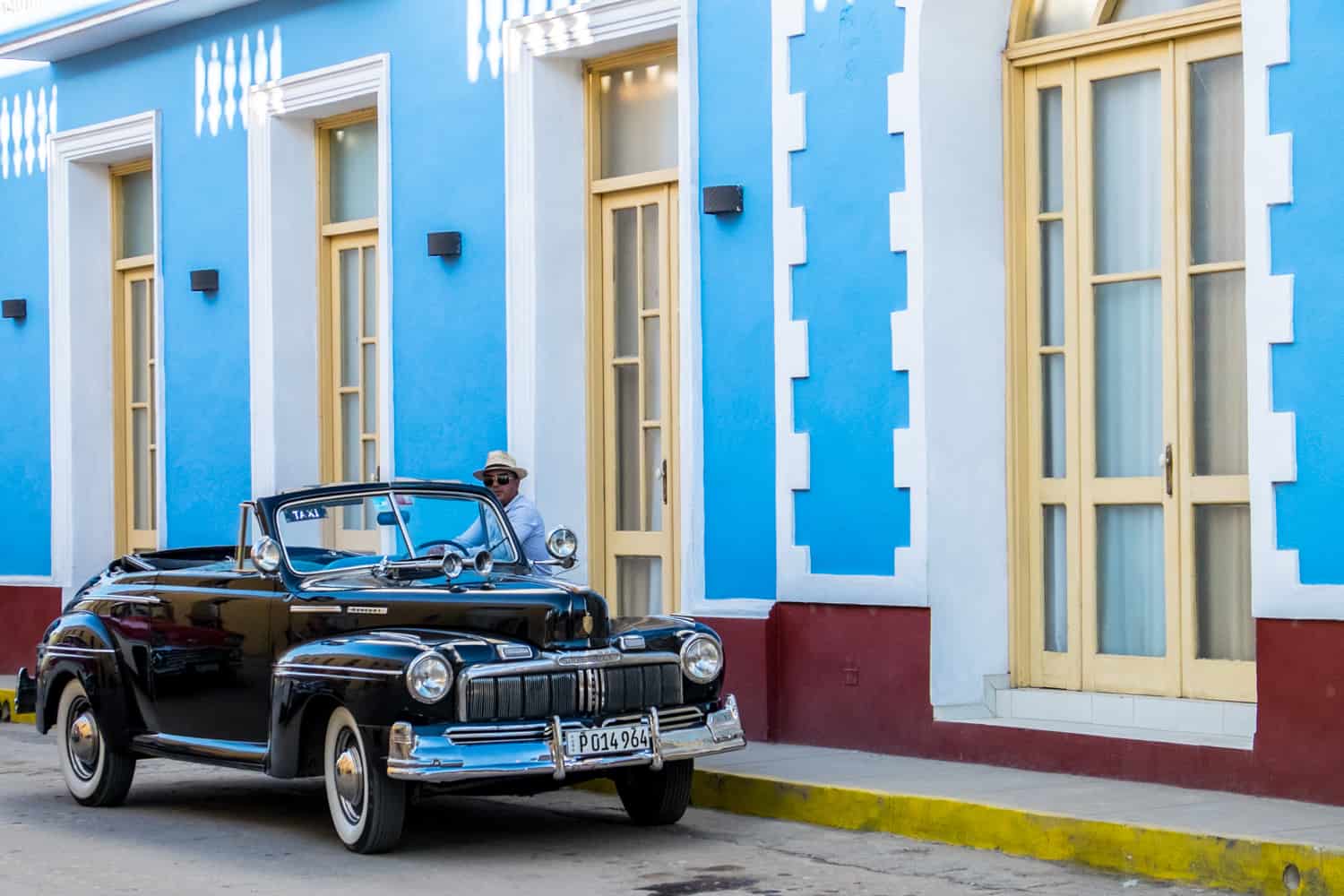
A typical Cuban Taxi.
When to Use a Taxi over a Bus
We often hired a standard taxi, not a collectivo, for shorter distances such as Varadero to Matanzas, Cienfuegos to Trinidad, and Trinidad to Sancti Spiritus.
You should plan as you go along according to what buses are available for your desired route and time. Be open and aware that you may have to spend more on a taxi to get to where you need to be or for an available bus connection, which is why we ended up in Sancti Spiritus.
Car Hire vs. Hiring a Driver in Cuba
We often found it cheaper to hire a driver for the day in all Cuban cities, getting out to the coastal fringes and lookouts, than hiring a car and driving ourselves. This option can often double up as a local tour guide experience.
A taxi for the day may seem expensive but is the best option, especially when sharing the cost with another or a small group – cheaper than hiring a car AND paying the fuel on top. One litre of fuel costs just over 1 CUC ($1), and private car hire can be around 70 CUCS ($70) daily.
The average cost to hire a taxi for the day was 60 CUC ($60), including fuel. Around two-thirds of that money went to the driver.
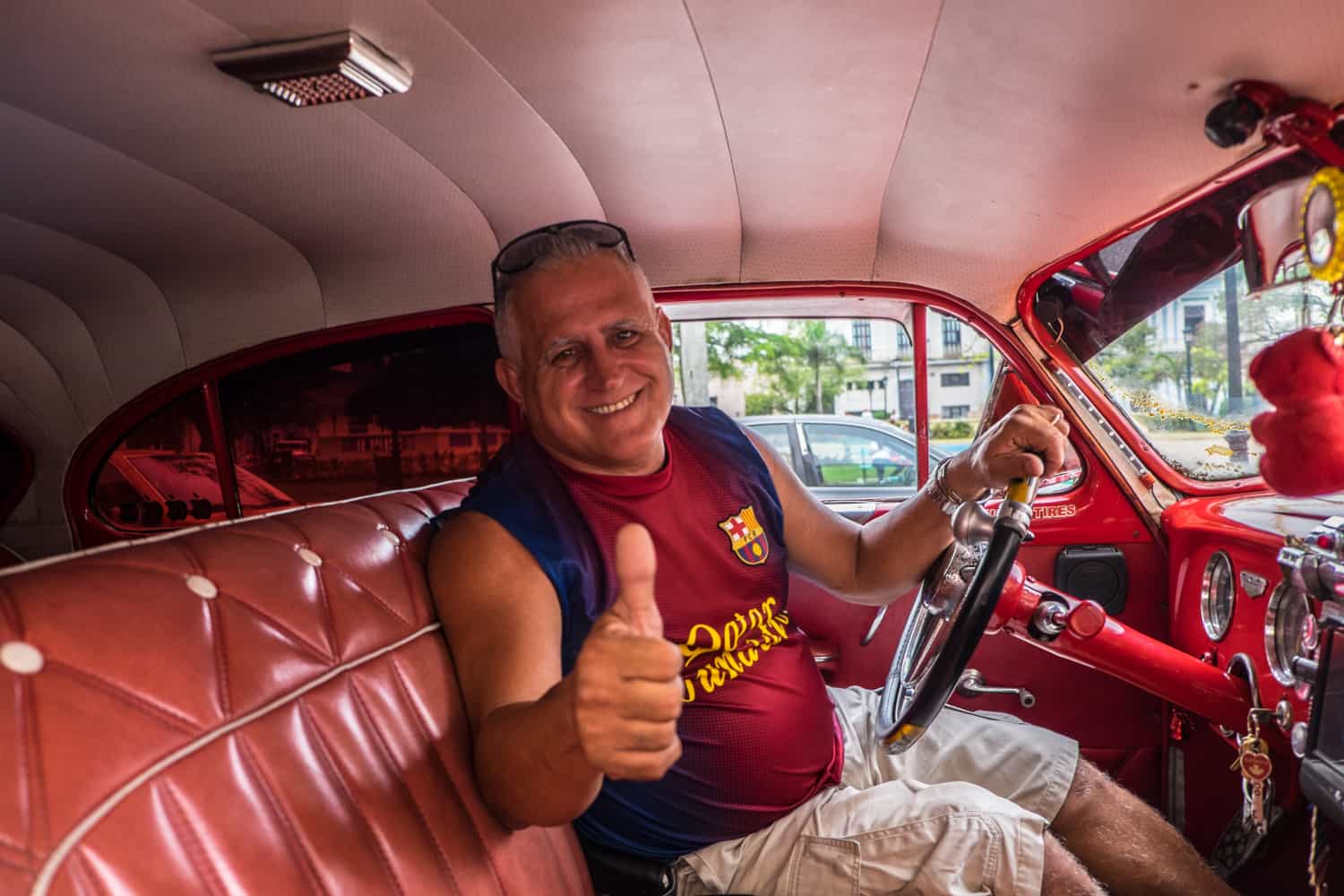
Our taxi driver in Cuba showed us around in a classic car.
Access to the Internet
Does Cuba have Internet? Yes, except availability is limited to public plazas (squares) or within the big hotels set on the plaza, and the cost of Internet in Cuba is high.
ETECSA buildings (blue logo) are at each plaza. You can’t miss them with their stupidly long queues. Here, you can buy a 1-hour card for 2 CUC ($2) or a 5-hour card for 10 CUC ($10), each with a code you enter on your phone. Your details are logged at the time of purchase next to the unique card number. Some hotels also sell these cards and let you lounge in the foyer while you surf the web.
Each log-in code has a visible timer, so you do not lose any minutes if you log out before your time is up. Therefore it is easier to buy 5-hourly cards to avoid long waits in line. Street hawkers will try to sell you the cards on the street, often with no discount or nothing that amounts to little more than a CUC. It’s not worth the risk.
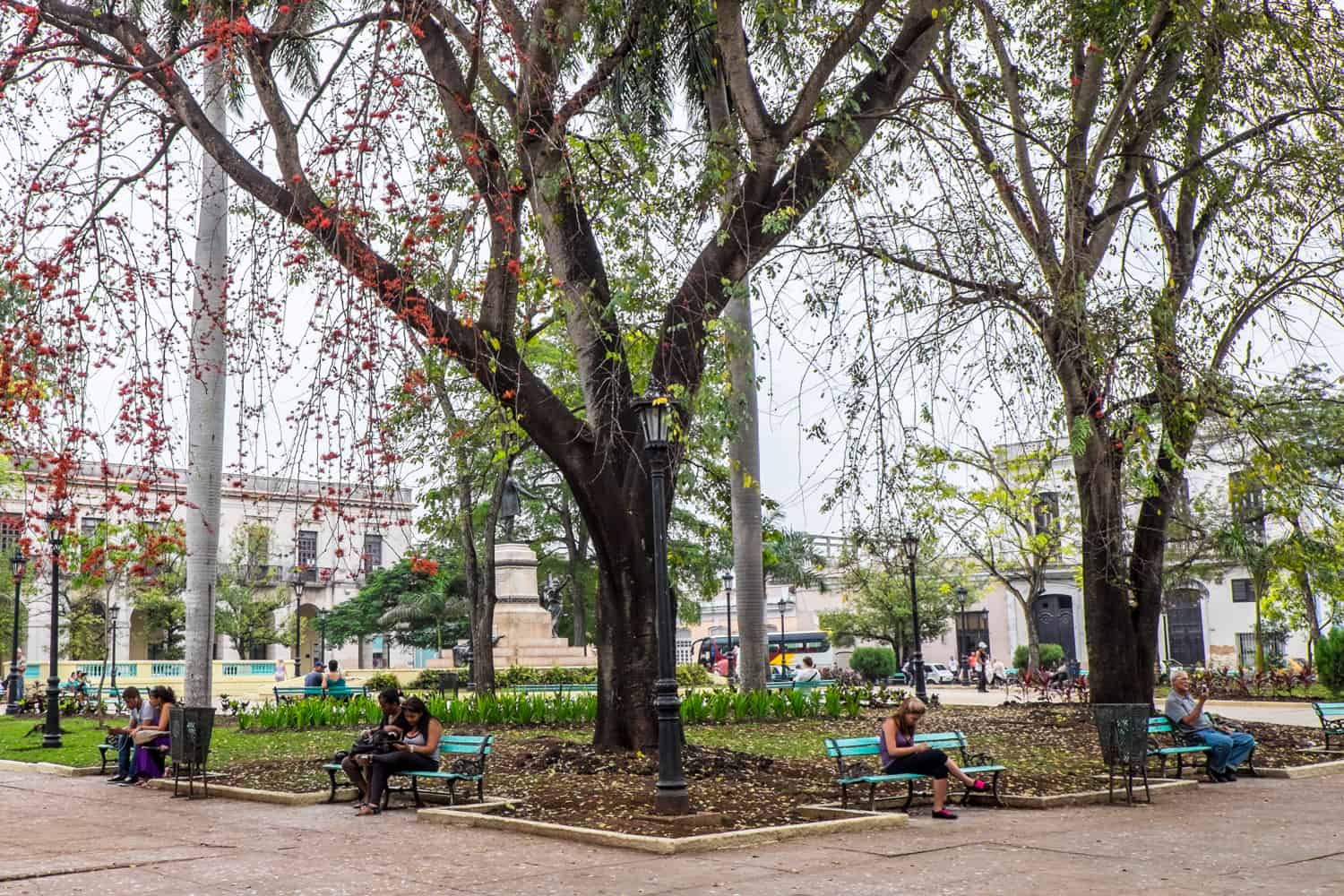
The Internet in Cuba has turned city Plazas from parks into wifi zones.
Internet was only introduced throughout Cuba in 2015, so the squares are now crowded with people with their heads in their phones. The only app available to Cubans on their phones back then was e-mail. Now the Internet is more available, another world has opened up to them (despite being monitored and limited).
A waiter told us that the youth no longer socialise, and many Cubans who make it abroad download what they need before coming home.
Are you annoyed by the price? In a country where the average monthly wage is $25, you can only imagine how much of an expensive indulgence the Internet is.
Do I Need to Learn Spanish?
Knowing basic Spanish in Cuba is essential for travel. At least have a Latin American Spanish phrasebook or translation tool such as Google Translate or a language phone app that can work offline.
You can travel around without Spanish skills, but your time will be frustrating or filled with mime! English is not as widely spoken in Cuba as you may think, especially when you move outside of established destinations on the tourist route.
Bring Medication & Essentials – Cuba’s Limited Supplies
Cuba may have one of the world’s best medical systems in practice, but it doesn’t have the resources. What medications exist are limited to locals (and rightly so), and big pharmacies are rare.
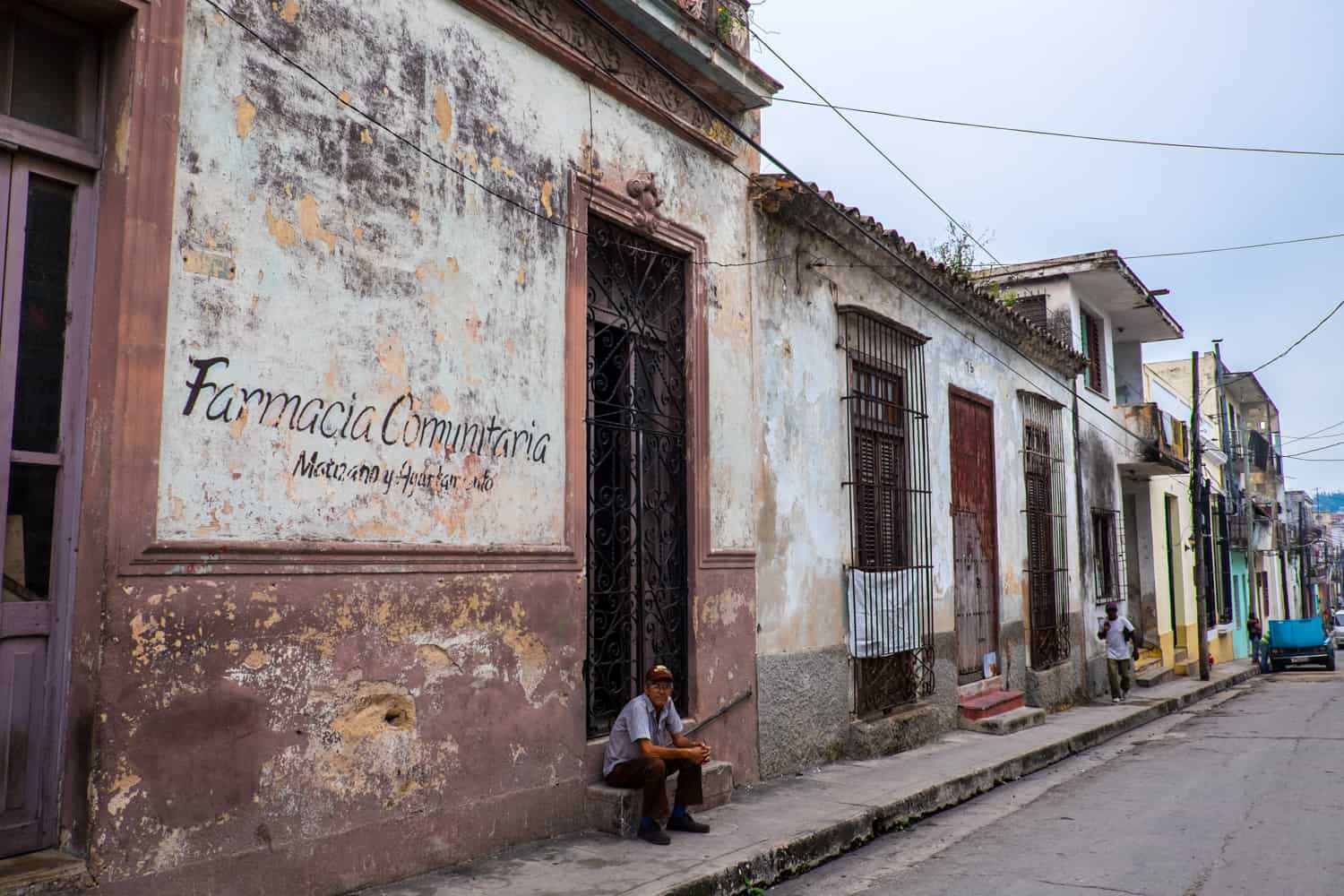
A local pharmacy in Cuba.
Before you go to Cuba, stock up. Bring Imodium and biodegradable wet wipes for bad days, Pepto-Bismol, travel anti-bacterial hand gel, painkillers, natural deet-free mosquito spray (the Incognito range is super), sun cream – all the essentials.
Why? If you stumble upon a store that sells items resembling medicines at home, you will be paying ridiculously high prices—likely three times the amount.
Laundry in Cuba also has an inflated cost, especially since the detergent is expensive for locals. Therefore the prices at a Casa for an average of 2-3kg of laundry come in high (up to 6 CUC / $6). Consider bringing travel wash with you for hand washing (Sea to Summit is one of my go-to ranges for concentrated formulas) or investing in the Scrubba Wash Bag (portable laundry system for travelling).
Consider leaving anything you have left over behind. The local people will appreciate it.
Daily Life in Cuba – The Ration Nation
The one aspect of local society you rarely find in detail in a Cuba travel guide is how life is built on a ration system and low wages. It means the things we take for granted are hard to come by or expensive for the locals. For example, no soap and toothpaste are included on the monthly ration list.
Consider what gifts to bring, such as soaps, general cosmetics, pens and notebooks that you can donate or give to your Casa owners to distribute. You will likely be asked often on the street for clothing.
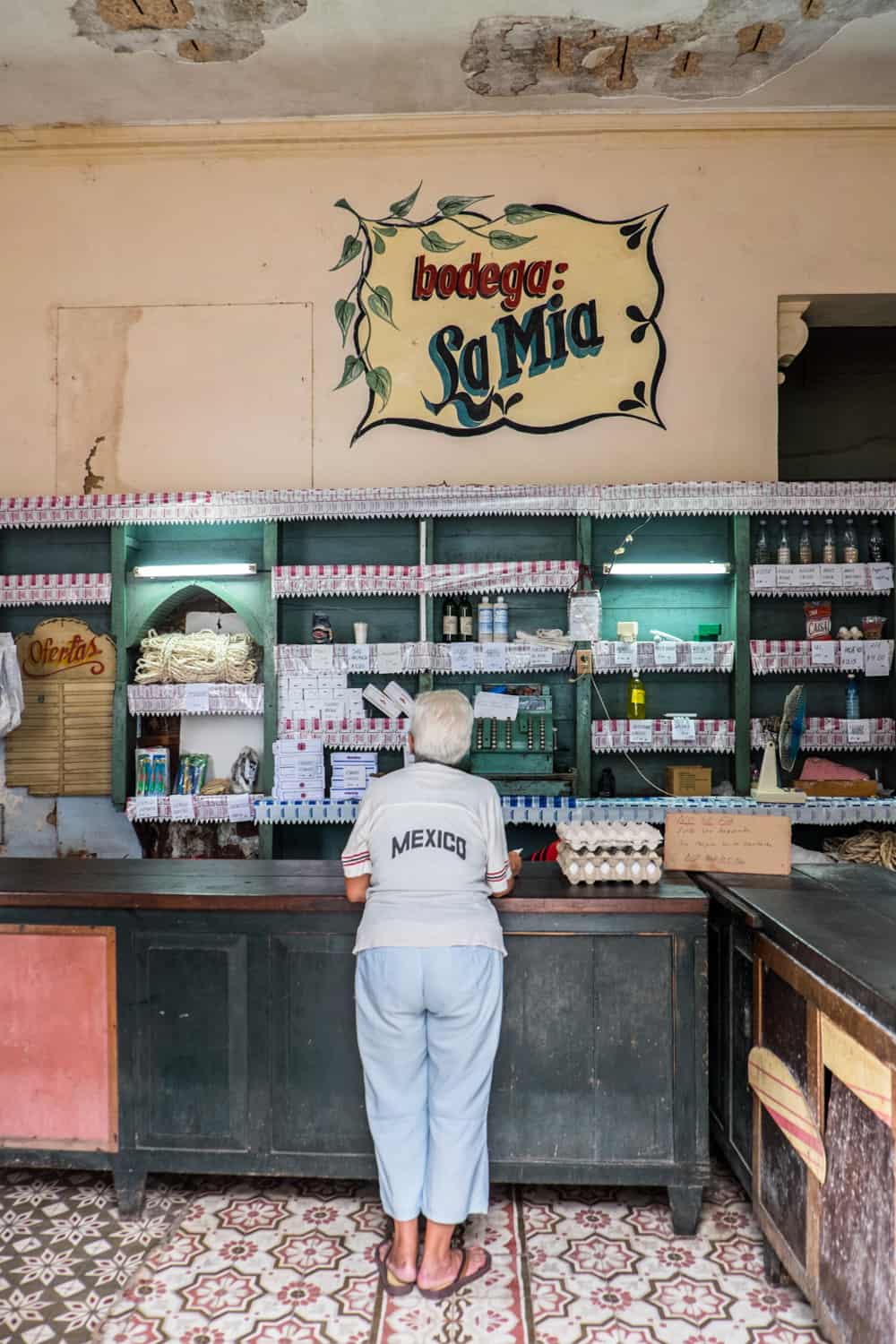
Soaps, cosmetics, pens and notebooks are hard to come by in Cuba. Consider bringing them with you to give to local people.
The Frustrations of Cuba Travel
Is Cuba worth visiting? Absolutely, but go there knowing it is as beautiful as it is heartbreaking, as random as it is challenging. Your senses will be in overdrive, and not everything will appear as magical as you assumed, especially once you dig deeper into what is happening there. However, such realisations soon put you back in your place – we were told Cubans are taught from a young age that “everything takes time”.
Suggested Books About Cuba for Inspiration
While a travel guidebook such as Lonely Planet comes in handy for on-the-spot planning, the complexities of Cuba are best explained with broader reading, most of which are personal accounts of the reality of living here or biographies of revolutionary figures.
- The Other Side of Paradise
- My Life – Fidel Castro
- The Motorcycle Diaries
- Trading with the Enemy: A Yankee Travels Through Castro’s Cuba
- Che Guevara: A Revolutionary Life
- Remembering Che: My Life With Che Guevara
- Last Dance in Havana
- Slow Train to Guantanamo
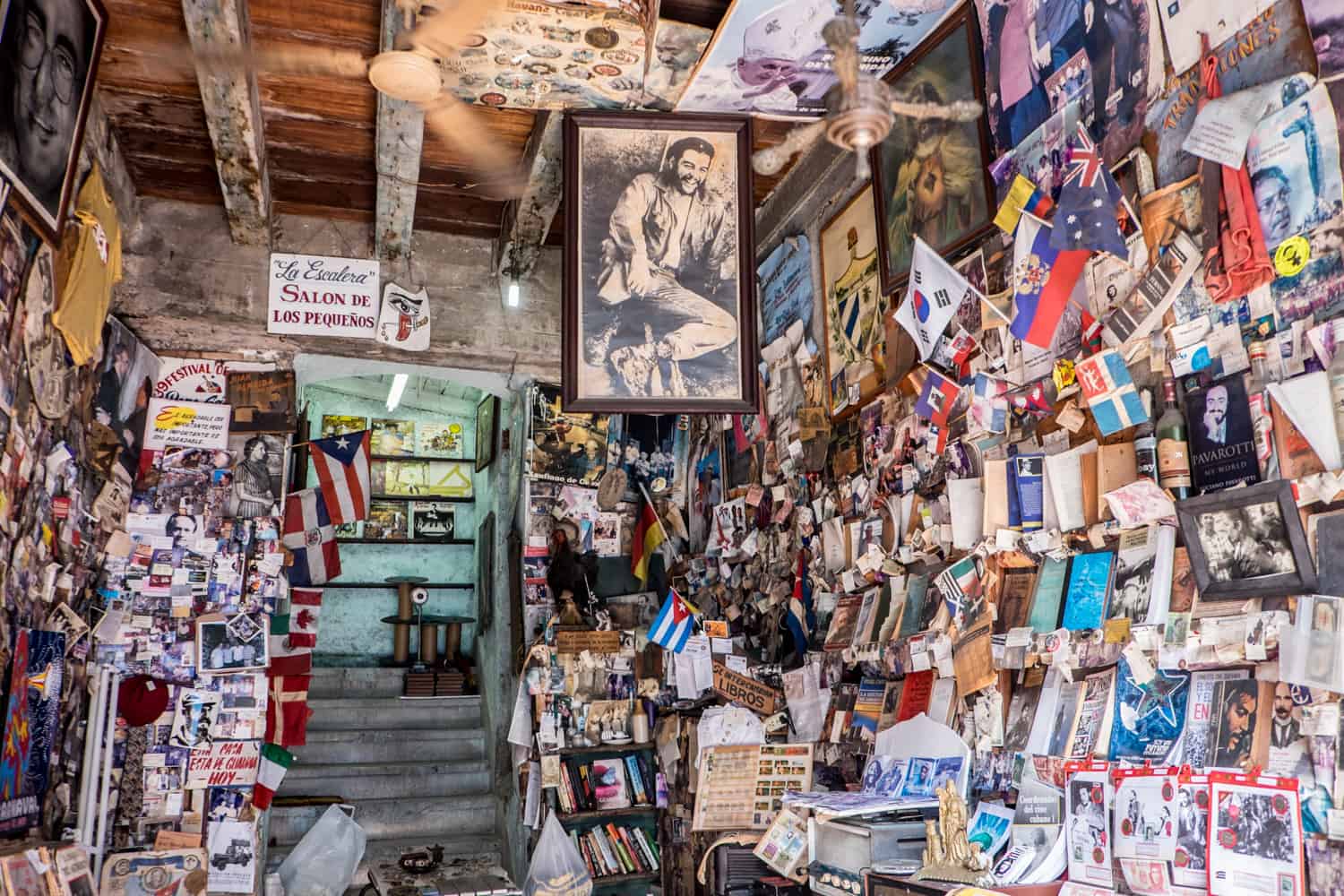
A bookstore in Cuba.
Planning to Travel to Cuba? Pin It!


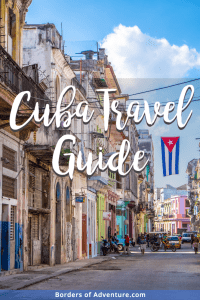

Jyoti basu says
This is such an incredible post. Thanks for giving us such valuable info. Definitely want to visit Cuba.
Rose says
Great post. It is so refreshing to read a post about Cuba that doesn’t glamorise the country and the regime. So many articles, guides and blogs portray Cuba as a opportunity to step back in time with beautiful retro cars etc and we should all go there before it is taken over by McDonald’s.
We travelled there early last year and was surprised by the level of poverty, late model European cars and also the nature of the propaganda outside of the tourist areas.
I was most surprised by the investment in the upkeep of pre-revolution monuments, including those to US governors. I guess I expected them to be cleansed in a similar way to what occurred in the Russia and other areas but they were beautifully maintained. This was both impressive and awfully sad given the state of some of the apartments that overlook said monuments.
I will return to Cuba one day to see what happens as it opens up to the world and US investment. As you say Cuba is a fascinating country.
Becky says
Thanks for posting this. I keep going back and forth on whether or not I want to visit Cuba in 2017 (I mean, I do want to, but I also want to visit other places!). Such a fun internal debate to have!
Christina says
This was a wonderful post. I’m traveling to Cuba from my home base in NYC in February and couldn’t be more excited. Thanks for all of the advice!
Nick B says
Hey Becki. Very thorough article on this most amazing island. I was there for two weeks last March with my wife and some friends and we loved it. . We had used a local tour organiser to move us around and picked out our own Casas. Not as independent as you but we also got to stay with and to talk with the locals. They were so friendly and curious about the outside world.
One thing about the money changing system is that they also take British pounds so a traveller from the UK doesn’t have to buy $ or € and then change them again once you land.
You are so right about being relaxed about time. We were lucky enough to have our own transport between our different towns (Havana, Vinales, Cienfuegos, Trinidad, Santa Clara and Cayo Santa Maria for a short beach relax at the end) but we heard from the locals about how they wait for hours by the side of the road for a bus (aka converted truck).
All in all, a fantastic country to visit right now. It will be interesting to see how it evolves with the changing political climate around it.
Thanks for reactivating some great memories.
Lotte says
What a comprehensive post! Love your honesty about traveling around Cuba, it’s a country on a crossroads and we’ll just have to wait and see what the future holds…
Heidi Siefkas says
Very comprehensive post.
Buen hecho (well done)!
I have traveled to Cuba over 20+ as an American. I agree with packing patience + OTC (over the counter). Also it is important to note it is CASH ONLY for Americans. Plus, everyone should bring their own toilet paper and hand sanitizer.
Why? The baños in Cuba are interesting. You most likely will have an attendant. So, be prepared with 25 cent coin for some paper. There most likely will not be a toilet seat, nor soap. Bring your own stash of TP and hand sanitizer.
Cuba is a fascinating place.
Ashlea says
I want to go to Cuba so bad! Thanks for sharing this, it will definitely come in handy when I finally decide to make the trip down!
Andrew Scott says
Thanks for writing this extensive guide, Becki! It’s coming in handy as I plan for a trip to Cuba this January! The idea of “getting away” from technology sounds therapeutic, but it must have been challenging from a work standpoint not to have regular internet access. How did you handle this? Did you embrace it? Did you outsource necessary tasks?
Becki says
It was hard at first, but I embraced it. All three of us were off work for a much-needed holiday and adventure and this very much forced us into that. An hour here and here for internet usage in each city allowed us to catch up on main things and keep in the loop, and that was perfectly fine. Like any trip, it’s best to get as much as you can in order before you leave. Also, December / Christmas / New Year is the ideal ‘quiet’ season for workload.
Andrew Scott says
Thanks for the thorough response, Becki. 🙂
Anna says
Read all of the post despite not having the desire to visit Cuba anytime soon. Loved your tips and insights, they are very thorough.
As for books I’d add “Cuba” by Richard Gott which is all about the history of the island and on a lighter note “Our Man in Havana” by Graham Greene.
Elle Croft says
Great guide, Becky – there aren’t many people who have scratched the surface like this so it’s great to know the ins and outs from someone who really knows. Cuba is on my list so this will definitely come in handy one day!
Becki says
Thank you! It was hard work digging deeper there and finding people who could/would even talk about things.
The social-commentary piece with destination focus is coming shortly.